Domestic and non-domestic energy performance certificates: review
Analysis of responses to our three public consultations about energy performance certificates (EPCs).
6. Topics: Issues, Analysis and Possible Actions
The thematic analysis, the workshop presentations, discussion and feedback, and the supplementary topic notes with additional sensitivity analysis are brought together in this section through identifying specific issues within each of nine topics, analysing the state of play, and identifying possible actions that the Scottish Government could consider to enhance the EPC process going forward.
6.1 Topic: Traditional Buildings
- Dealing with Traditional Dwellings
- Use of Defaults, Accuracy and Real Data
- Appendix T
- SAP, RdSAP, and SBEM Metrics
- Stone Wall Constructions, Heat Loss and U-values
- Solid Brick Walls, Heat Loss and U-values
- Insulating Stone and Solid Brick Walls
- Thermal Mass
- New technologies: Shutters
- New technologies: Ventrolla
- ‘Non-traditional’ dwellings in Scotland
- Taking Account of Insulation that Cannot Be Seen
6.1.1 Dealing with Traditional Buildings
Issue:
The public perception is that SAP, RdSAP, SBEM, and EPCs do not take account of ‘traditional’ buildings.
Analysis:
At one level, this perception is accurate. In the context of SAP, RdSAP and SBEM methodologies and EPCs, the term ‘traditional’ is not utilised in the assessment of the energy performance of a building; nor are the terms ‘older’, ‘historic’, or ‘listed’. These labels do not feature in the data items collected during a SAP, RdSAP and SBEM survey, they do not appear on the EPC, nor are they entered into the software to calculate the building’s energy performance, nor are they a reason for removing recommendations from the EPC: “Recommendations should be removed only if there is documentary evidence showing that a specific recommendation is not appropriate. A listed building or a property in a conservation area is not sufficient grounds in its own right to suppress a recommendation.”[78]
By contrast, ‘pre-1919’ is useful for exactly these reasons: it is used in assigning the default U-values to different constructions in the building. The SAP, RdSAP and SBEM calculation methodologies do differentiate properties by different age bands, e.g. pre-1919. They also differentiate wall constructions by stone, solid brick, mud, timber, cavity and system-built. Stone walls are further disaggregated into sandstone / limestone, or granite / whinstone. Depending on the age of construction of the building, these wall constructions are assigned different heat loss U-values. If ‘traditional’ is mostly synonymous with older properties, then differentiating properties by the age band of their construction, e.g. pre-1919, does take traditional dwellings into account.
The Supplementary Topic Note 1 on RdSAP and U-values further demonstrates that solid walls, stone walls, pre-1919 walls or other wall constructions are not simply one size fits all. The calculation models explicitly differentiate different types of solid walls, e.g. solid brick, different stone types, timber frame and cob. In assigning default U-values for stone walls, SAP and RdSAP distinguish between different types of stone, and then takes wall thickness into account. Further, the models also take account of the presence of an internal finish where it includes an air gap within the stone and brick wall constructions (e.g. with internal drylining or lath and plaster finish). The result is a wide range of U-values produced for dwellings falling within the age category of pre-1919 dwellings[79]. The issue is whether the range of U-values within the EPC models is sufficient, or if there is a need to expand the range. These concerns are examined below.
No further action is required with regard to the EPC-related calculation, assessment, reporting or database processes. The Scottish Government should consider publishing as part of their online guidance leaflets[80] on EPCs additional information on what SAP / RdSAP / SBEM does and does not take into account within the calculations, and how the models differentiate between different building constructions.
6.1.2 Use of Defaults, Accuracy and Real Data
Issue:
There is a perception that replacing defaults with real data or more accurate data would improve the energy assessment of traditional buildings.
Analysis:
SAP, RdSAP and SBEM are methodologies used to describe energy performance calculation models. They do not determine precisely the energy performance of every individual building; rather, as assessment tools, they work within a range of accuracy, and within a set of assumptions. However, that said, these models should support a standard of assessment that is appropriate and sufficiently discerning to allow us to compare different properties, building types, and constructions, to support policies and programmes to actually improve the energy performance of the building stock, and to report on the impact of these improvements.
If real performance data were available on every building, then we would not have to model the building’s energy performance; the actual performance data could be used. Without real performance data on a building, the use of default data of some sort is required to complete the energy performance assessment. In-situ measuring of thermal performance would be one approach to obtaining building specific U-values that could be used in the calculation methodologies. To be more precise requires a great deal of time, equipment and expense[81]. It is not feasible, practical or cost effective to monitor every individual property in detail, or to calculate or measure the actual U-value of all the fabric components within every property, hence the use of defaults that are representative of the construction of the building fabric.
The SAP, RdSAP and SBEM calculation methodologies are empirically-based models, that is, they are derived from data collection and research into the actual energy performance of existing buildings. Changes to these methodologies arise in the same way, through more data collection and research. Empirical data collection and in-situ testing resulted recently[82] in solid brick wall U-values being revised lower because the walls performed better than previously thought. The models continue to evolve as more data becomes available.
The published guidance to the SEEP Pathfinder Phase 2 funding included specific requirements to monitor the performance of the funded projects with regard to energy consumption, temperatures and relative humidity to better evaluate the impact of the refurbishment works. The guidance detailed the type of monitoring, the methodology, and the equipment that would be required.[83] Unfortunately, SAP, RdSAP and SBEM do not use ‘operational data’ in their assessment of the energy performance of buildings.
At least, one local authority appears to be extending this before and after monitoring approach to include “air pressurisation, in-situ U-value, and thermography on a number of specific dwelling types as part of its HEEPS ABS programme over the next two years”[84].
Data collection is important if the accuracy of the calculation methodologies is going to be improved; the more empirical research the better. There is a need to not only collect the data, but to gather it and collate it, to inform the process as well.
Possible Calculation action:
The Scottish Government to arrange for the data gathered through the monitoring of the SEEP Pathfinder projects and HEEPS ABS to be collated and assessed against improving the accuracy of the calculation methodologies.
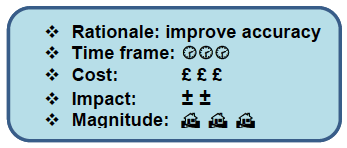
6.1.3 Appendix T: Improvement Measures for Energy Performance Certificates
Issue:
The recommended improvement measures on the EPC are inappropriate for traditional stone wall dwellings.
Analysis:
As long as the criteria set out in Appendix T are met, a specific improvement measure is recommended on the EPC if it increases the SAP rating of the dwelling by 0.95 SAP points or more. A considerable number of concerns were raised in the public consultation responses that this process results in measures being recommended that are inappropriate for traditional dwellings. This is dealt with in more detail in Section 6.2 on EPC Reporting and Recommendations.
6.1.4 SAP, RdSAP and SBEM Metrics
Issue:
SAP, RdSAP, and SBEM are deemed to be fundamentally flawed with regard to assessing ‘traditional’ buildings
Analysis:
Many of the concerns raised on this issue were included above as they were concerned with the accuracy of the assessments. When both the methodology and modelling categories were filtered on ‘metric’ only, the resultant four responses were concerned with the predicted fuel bills compared to actual household fuel bills, and that the impact of a number of improvements made to traditional properties, despite their capital cost, achieved a post-improvement rating that the respondents were unhappy with.
The issue of the SAP, RdSAP and SBEM metrics are examined in more detail in Sections 6.3 and 6.4 below.
No further action:
Changing the underlying metric of SAP, RdSAP and SBEM was outside the brief of this research project.
6.1.5 Stone Wall Constructions, Heat Loss and U-values
Issue:
SAP, RdSAP and SBEM underestimate the thermal performance of stone walls.
Analysis:
The default U-values for a number of materials have been revised several times, including stone and solid brick wall constructions, since the requirement for EPCs was first introduced. For example, stone is no longer a single, age-related U-value for each stone type. Since 2012, stone walls take account of the age of the property, the type of stone, the thickness of the wall, and whether or not there was an internal lining (e.g. lath and plaster), resulting in a very wide range in stone U-values[85]. The question is whether these changes go far enough.
Several respondents to the public consultations certainly do not think they do, citing various research papers / reports where lower U-values were monitored on site. Where these papers and reports were reviewed as part of this exercise, many were found to be less than robust or systematic in their data collection. Yes, they reported on U-values being measured on-site, but were too often concerned with monitoring a single building or a very limited number of dwellings. There was further uncertainty about whether the data collection was in keeping with the international standard BS EN ISO 9869[86] which describes the apparatus to be used, the calibration procedure for the apparatus, the installation and the measurement procedures, the analysis of the data, including the correction of systematic errors and the reporting format when measuring U-values in-situ. Better reporting of the methodologies used, and more systematic reporting of the variables monitored, would enhance the reported results.
One suggestion raised during one of the workshops involved a slight amendment to the algorithms that are used in RdSAP to calculate the stone wall U-values. The impact of this suggested change is modelled in Supplementary Topic Paper 1. However, this modification would need to be supported with more systematic in-situ monitoring for it to be taken forward.
Within the Scottish building stock, more types of stone are used than just sandstone limestone, granite and whinstone, but the SAP, RdSAP and SBEM calculation methodologies only explicitly recognise these four (although effectively distilling the four down to 2 types). Other types of stone are dealt with by the conventions[87]. Including for more stone walls types was highlighted by a number of participants at the workshop.
Whether the current range of U-values is sufficient, or the algorithms need amendment, will need further in-situ testing and empirical data collection[88]. Certainly, given the range of stone types and constructions common across Scotland, this issue merits further investigation.
Possible Calculation action:
A systematic research programme to measure in-situ U-values for different existing stone wall types to assess the validity of the current range of U-values within RdSAP; proposed revision to the stone wall U-value calculation algorithms. This research program would probably take at least 2 years to identify and monitor sufficient properties to provide a robust empirical basis to make changes to the existing algorithms. This research programme could assess the impact of the wall condition and water saturation levels on the thermal performance of the walls.
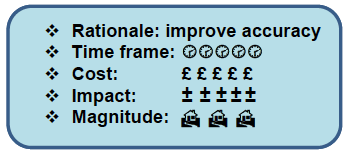
Possible Calculation action:
Extending the range of stone wall types would require collating more empirical data in terms of the type of stone and its heat loss performance so that default U-values could be derived and included into the software. This certainly could be part of the above research program. In the interim, a piece of research could collate and calculate default U-values that could be published as a stand-alone booklet (or more likely as an online data reference) that could be referred to by assessors.
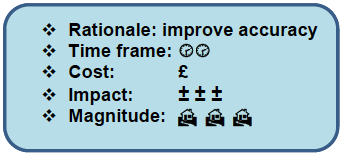
No further action:
Concerns were also expressed about some of the constituent components of a traditional stone wall, e.g. lime and cement mortars, lime and cement render coatings, as well as the impact of the water saturation of the wall. Currently, the default U-values for existing buildings are derived for the overall wall construction, rather than breaking it down into its constituent components. Even in a detailed U-value calculation the impact of mortar and render coatings is almost negligible as they are such a minor element in the wall. Again, the condition of the wall is not taken into account in the current energy assessment survey.
6.1.6 Solid Brick Walls, Heat Loss and U-values
Issue:
SAP, RdSAP and SBEM underestimate and over-estimate the thermal performance of many solid brick walls.
Analysis:
Using empirical data, the default U-values for solid brick walls for existing dwellings were revised downwards in November 2017 as part of RdSAP 2012 v9.93[89], to more closely reflect the U-values monitored through in-situ testing rather than a theoretical calculation. Despite this revision, and the research report it is based upon[90], the default for solid brick wall default U-values in RdSAP remains ‘one size fits all’. The same default is used whether the solid brick wall is a half-brick thick, 1-brick thick, 1.5-brick thick or 2-brick thick (despite the empirical data showing an even larger discrepancy between the calculated theoretical U-values and those measured in-situ).[91]
Given that the empirical study was based on a study of 300 English houses, a 1-brick thick wall may have been the most common wall construction measured, but half-brick thick walls (i.e. between 150-180mm thick) are particularly common within the construction of the close wall in pre-1919 Scottish tenements, and 1.5 and 2-brick thick walls (i.e. between 330 – 500mm) are common (where brick was used) in the external walls of the lower floors of the pre-1919 Scottish tenements.
The SAP, RdSAP and SBEM calculation methodologies introduced the precedent of differentiating stone walls according to wall thickness in 2012. A similar approach could be applied to ranges of solid brick wall thicknesses, but rather than use an algorithm as with stone wall thicknesses, a range of thicknesses could be identified for each brick type. Assessors already measure wall thicknesses as part of a survey, so identifying the wall type as solid brick and entering its thickness could be used to access the appropriate default U-value. The result of such a change would be that the thinner solid brick walls to the close would lose more heat, while thicker solid brick external walls would lose less heat, with consequential impacts on the resultant SAP ratings.
Possible Calculation action:
Adopt thickness related U-values for half-brick thick, and for 1.5 and 2-brick thick walls, amend Appendix S accordingly, and then embed the appropriate defaults into the SAP, RdSAP and SBEM software models.
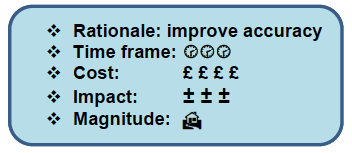
6.1.7 Insulating Stone and Solid Brick Walls
Issue:
SAP, RdSAP and SBEM can underestimate the impact of external and internal wall insulation on stone and solid brick walls
Analysis:
Regardless of the pre-1919 default stone wall construction U-value derived from the type of stone, the wall thickness, and the presence of an air gap, all of this variability is then ignored in the SAP and RdSAP calculations when either internal or external wall insulation is added to the wall. Depending on the thickness of the added wall insulation[92], SAP and RdSAP then defaults to one U-value for each insulation thickness[93]. Similarly, with solid brick walls, the beneficial effect of the presence of an air gap is ignored when either internal or external wall insulation is added to the wall.
Differential U-values could be calculated within the RdSAP program to readily account for the initial wall thickness, the air gap, and the thickness of the added insulation.
Such an approach would also address another issue discussed in more detail in Supplementary Topic Paper 1, i.e. accounting for wall insulation of less than 50mm, and instances where the thickness of the insulation falls between one of the standard default thicknesses[94]. The effect of this rounding down of the wall insulation thickness is to use a higher heat loss wall U-value in the calculation, therefore underestimating the SAP score to be achieved.
Possible Assessment action:
Publish a convention to accommodate wall insulation that is less than 50mm thick, or falls between the default thicknesses. A worked example is set out in Supplementary Topic Paper 1.
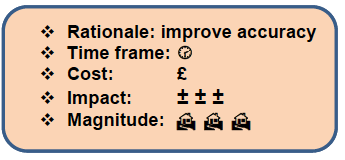
6.1.8 Thermal Mass
Issue: RdSAP underestimates the impact of thermal mass on Scottish dwellings.
Analysis:
Thermal mass is taken as an average, medium thermal capacity for all properties assessed in RdSAP. By contrast, SAP evaluates thermal mass on a scale of low / medium / high based on the calculated thermal mass parameter. A separate Topic Paper was prepared on thermal mass for this report (see Supplementary Topic Paper 2 on Thermal Mass).
From a sensitivity analysis of 100 REEPS archetypes, changing the dwelling’s thermal mass has an impact on the energy performance of a dwelling, with a difference between high and low thermal mass being up to 8 SAP points in difference. Across the sample of 100 dwellings, the mean net change in the SAP score difference was -1.4 SAP points, but the sample of houses was heavily weighted towards stone-built properties with almost no light thermal mass timber frame dwellings included in the sample. The overall impact also is heating system dependent, with a much narrower range of SAP scores seen amongst unresponsive systems than with wet central heating boilers. Adopting a variable thermal mass would impact on Scotland’s energy performance indicators.
While it is possible to calculate the thermal mass parameter of each dwelling, it would also be very time consuming. Two approaches suggest themselves. The first is to use look up tables that are already available within the SAP conventions[95] - so the assessor would make a determination while on site, as part of the survey.
An alternative approach would be to revise Appendix S and the RdSAP software, so that the software made the determination of thermal mass based on the dwelling characteristics entered. Using the software to make the determination would only require one additional data collection item to be noted during the survey, and entered into the software, that is, whether the internal partition walls were effectively a masonry construction or a timber frame construction.
Possible Calculation action:
Include an assessment of the dwelling’s thermal mass into Appendix S of the SAP manual, and within the RdSAP software.
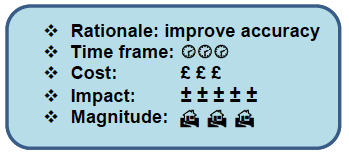
6.1.9 New Technologies: Shutters
Issue:
SAP and RdSAP do not take account of shutters.
Analysis:
The presence of shutters is a feature within some ‘traditional’ buildings, as well as some modern low energy design buildings. Although there is a current ISO standard for assessing the thermal performance of shutters[96], it is not included in the SAP, RdSAP or SBEM methodologies. This issue is dealt with in Section 5.9 on measuring windows.
Historic Scotland (now Historic Environment Scotland) published in 2013 a guide on Fabric Improvements for Energy Efficiency in Traditional Buildings[97] which included fitting shutters as one of the possible energy efficient improvements in keeping with the character of traditional buildings. If a person acted on this recommendation they would get no benefit currently in SAP or RdSAP. As the international standard exists already for modelling the impact on thermal performance, it seems a straightforward item to include within SAP and RdSAP.
Possible Calculation and Assessment action:
Include shutters within RdSAP as an item to be recorded during the survey.
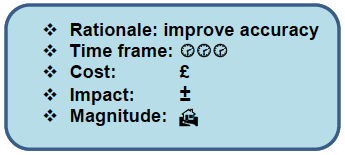
Possible Reporting action:
Incorporate shutters into Appendix T so that they may appear as a possible improvement.
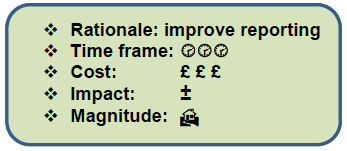
6.1.10 New Technologies: Ventrolla
Issue:
SAP and RdSAP do not take account of the Ventrolla draughtproofing system.
Analysis:
The Ventrolla draughtproofing system is not a ‘new’ technology as it has been on the market since the 1980s[98]. SAP and RdSAP do not specifically take account of the proprietary Ventrolla draughtproofing system. However, SAP and RdSAP do include an assessment of the draughtproofing of windows and doors within their ventilation calculations. If Ventrolla draughtproofing was installed in a building it should be taken into account by the assessor while surveying the ventilation characteristics of the dwelling.
No further action
Draughtproofing is already assessed in RdSAP and in Appendix T as an improvement.
6.1.11 Non-traditional dwellings in Scotland
Issue:
There is no differentiation between types of non-traditional housing in RdSAP.
Analysis:
Whilst the emphasis in this section has been on ‘traditional’ dwellings and constructions, several public consultation respondents specifically queried whether ‘non-traditional’ buildings should not receive similar considerations. Within RdSAP currently, for non-traditional buildings it is a matter of ‘one size fits all’. All non-traditional / system-built constructions (and the two are not necessarily the same) are reduced to one catch-all, ‘system-built’ category within RdSAP. Non-traditional dwellings / system-built properties, regardless of the type of non-traditional construction, built during the same age band, are deemed to have the same heat loss wall U-value.
By contrast to the concerns expressed above on the appropriateness of the Appendix T recommendations for traditional walls, Appendix T makes no recommendations for insulating the walls of ‘system-built’ dwellings. Grant schemes where the recommendation has to appear on a dwelling’s EPC for the measure to be eligible for inclusion have had to develop work-arounds for non-traditional properties or exclude them.
As with the discussion above on including more stone wall types within RdSAP, more non-traditional building types could be included with RdSAP. The basis for collating a wider array of wall U-values already exists – The Guide to Non-traditional Housing in Scotland 1923 -1955[99], and all of the more detailed, individual BRE reports on specific non-traditional dwelling types. As a starting point, theoretical U-values could be calculated and built into RdSAP, so that if the assessor could identify the type of non-traditional dwelling then it could be selected within RdSAP, and the appropriate U-value assigned. Failing the ability to identify the non-traditional dwelling, the current ‘one size fits all’ default U-value would continue.
Concrete and metal non-traditional dwellings represent at least 6%[100] of the Scottish dwelling stock, and an element of the stock that is generally expensive to insulate.
Possible Assessment action:
‘System built’ conjures up negative perceptions, and the term should be switched to ‘non-traditional’. System-built describes a particular method of construction; not all non-traditional housing in Scotland is system-built.
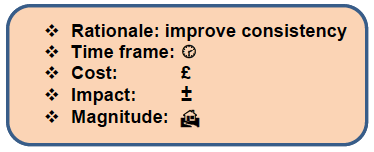
Possible Assessment action:
Clarify conventions with regard to using ‘system built’ as a wall type. This designation should only be used after all non-destructive means have been employed to categorise the wall type as this has a big influence on how measures are automatically generated for wall insulation.
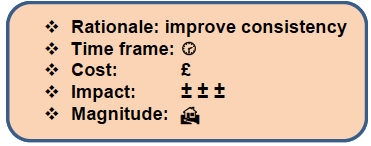
Possible Calculation action:
Use The Guide to Non-traditional Housing in Scotland 1923 -1955, and other individual BRE reports on specific non-traditional dwelling types, to calculate theoretical U-values for different non-traditional dwelling types and incorporate them into SAP and RdSAP.
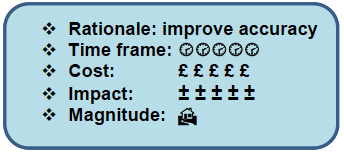
Possible Reporting action:
Identify appropriate wall insulation techniques for different non-traditional dwelling types so that the EPC will potentially recommend insulating the walls.

6.1.12 Taking Account of Insulation that Cannot Be Seen
Issue:
Insulation installed in a dwelling is not being taken into account within the energy assessment of the dwelling because it cannot be seen.
Analysis:
The RdSAP assessment is a non-intrusive survey. As noted by one respondent,
“EPC assessors are refusing to accept that walls, floors and roof spaces have been insulated unless they can see it. So we are having properties given a low EPC rating despite the fact that we have installed insulation in the floors, walls and roof and despite the fact that we can exhibit plans showing the specification of this insulation.”[101]
Within RdSAP, the conventions governing adding insulation to the assessment require documentary evidence that the insulation is present. Visible evidence may not be available. With internal wall insulation and room in the roof insulation, unless the assessor is on-site while the insulation is being fitted, surveying the dwelling even a day later may result in the insulation being covered, e.g. by plasterboard. A dwelling that has had cavity fill carried out in the past may be re-rendered or externally clad so the drill pattern is no longer visible. An assessor is not able to accept solely the occupant’s word that the insulation has been added; the assessor needs corroborating evidence. But then again, what guarantee is it that a property has effective cavity fill just because there is a drilling pattern? A whole industry has sprung up over the last couple of years whereby old cavity wall insulation is extracted and the cavity refilled, because the insulation has disintegrated, if it was ever there at all.
The system therefore needs to develop a mechanism for householders / owners / landlords to state what has been done to the dwelling and provide evidence so the surveyor can take this into account.
One approach would be to have contractors log completed work into an online database. Much insulation work is done currently by contractors that are PAS2030 compliant. As part of their compliance requirements they sign off ‘certificates of conformity’ for all PAS2030 related work, but they keep this certificate for themselves. A copy could be given to the householder, or lodged through an online portal, so that an assessor could check what work has been done.
Another option would be to allow the assessor to take account of a minimum default thickness and select an addenda item in the RdSAP software that would produce a note on the EPC that the assessment takes account of occupant declared insulation that was not specifically seen. A signed supporting letter or declaration from the householder / landlord, or household / landlord or their photographs, could be the documentary evidence to support this approach.
Possible Assessment action:
Develop procedures and conventions to take account of insulation that cannot be seen. This would include adding an addendum to the data entry take account of insulation and improvements that do not meet the current standard of documentary evidence.

Possible Assessment action:
Develop a household log book akin to the benchmark log book for boilers in which contractors would sign off insulation improvements completed in a dwelling.

Possible Data Base action:
Develop a database alongside the EPC register to upload PAS2030 certificates (or the equivalent) that can be accessed by householders and assessors to check if insulation has been installed.
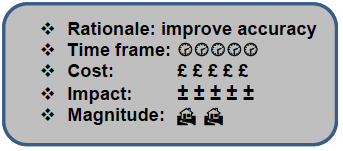
6.2 Topic: EPC reporting and recommendations
- Recommendations: Appendix T Method
- Reference values and costs within the Product Characteristics Database
- Meeting minimum standards
- Recognising new technologies
- Occupant behaviour and recommendations
- Format of the ‘Recommended measures’ table
- Inappropriate recommendations
- Building condition
6.2.1 Appendix T Methodology
Issue:
The recommendations presented on the EPC are too formulaic, lack flexibility, often inappropriate for the building, and do not take account of owner or occupier’s circumstances.
Analysis:
The recommendations that appear on a domestic property EPC are generated automatically by the SAP and RdSAP software. The measures that appear, the order in which they appear, and even the rationale why some recommendations appear and others do not, are governed by the Appendix T methodology which has a specific sequence for the consideration of measures, and a set of logical decision-making criteria to test the applicability of the measure, before making a recommendation.
The assessor does not select the measures to be included on the EPC report, yet they are allowed to delete recommendations if they have a good reason[102]. Thus, some recommendations appear on the EPC simply because a set of circumstances determined by SAP Appendix T are met, for example:
- wind turbines are recommended for all houses or bungalows located in a rural location, which do not have an existing wind turbine;
- solar hot water systems and solar PV systems are recommended regardless of the orientation, the overshading, or the appropriateness of the roof structure;
On the other hand, potential improvements are omitted simply because of Appendix T rules, for example:
- improvements being excluded from the list of recommendations because they do increase the SAP score by at least 1 SAP point (see Appendix A.6)
- internal or external wall insulation not being recommended for ‘system built’ properties
- failing to recommend connection to a local heat network, when one is available is discussed in more detail in Section 6.7.
The specification for all of the potential improvements is fixed within Appendix T and it is not possible for the assessor to amend the specification to model materials or equipment. Improvements cannot be adjusted to reflect better-performing products of a type (e.g. an insulation with a lower thermal conductivity value), or to take account of an owner or occupier’s circumstances (e.g. secondary glazing may be a more affordable and appropriate option for a householder than replacement double glazing). Low impact measures may not individually meet the SAP 1-point threshold to be recommended on the EPC, but when bundled together as a package, they may more than meet this minimum threshold to be included – but this option is not available currently.
The use of the term ‘Recommendations’ on the EPC may have some unintended consequences. The recommendations listed on an EPC are neither recommendations for the particular property nor a specification of works. However, the current process gives the impression that the recommendations are the result of a well-considered, authoritative process. Appendix T provides general suggestions, not ones specific to the property or its context, but nowhere is this stated on the EPC. This may lead to both inappropriate recommendations and poorly informed investment decisions. The wording could be amended to clarify the purpose and also to direct the householder to seek expert advice. ‘Potential improvement options’ may be more suitable than ‘Recommendations’. The format of the non-domestic EPC provides a model.
As an asset rating, the standardised recommendations on the EPC may have been sufficient; but as the EPC’s purpose expands to include elements of regulation and compliance, then so too should the advice report evolve.
Flexibility is needed in how the potential improvements are presented, and also in the type of measures included. With the setting of housing energy efficiency standards, the EPC could help to inform the owners or the occupants of the sorts of measures to invest in to meet a range of banded targets, for example, presenting packages of improvement measures based on achieving a set EPC banding threshold such as getting to SAP Band ‘E’ or ‘D’ or ‘C’.
Currently the two approaches would appear to present themselves: reformulating the whole of the advice report including the recommendations, along with the requisite changes to both Appendix T and all of the calculation software programs to accommodate these changes, or developing an 'addendum' or parallel process built upon the EPC.
There is recent experience with this latter approach, that is, the Occupancy Assessment (OA) process devised for the Green Deal Advice Report (GDAR). The OA was a separate, detailed assessment of the household including consideration of a wider array of improvements than available with RdSAP. However, it was built upon and informed by the EPC assessment, which had to be completed first. The assessor provided householder-specific, building-specific advice, coupled with assessments advice and improvements tailored to the needs of the building and the circumstances of the householder.
Expansion of the function of the EPC in this way would require the development of existing assessor skill sets, however many of these are already well developed. It would require that the assessor take on more responsibility in relation to the decisions being made on the range and type of improvement measures, including building packages of measures to achieve certain EPC bands. This will also offer the opportunity to recommend low cost measures which may not affect the SAP score, but may provide a benefit in comfort to the occupant. It would also include an element of energy advice.
Possible Reporting action:
In order to avoid significant material changes to the EPC as required for EPBD, consideration should be given to a separate associated energy efficiency advice report or improvements report. This report would be both methodologically and administratively linked to the EPC itself.

Possible Reporting action:
The format of the EPC in Scotland should reflect on the potential for assistance through Scottish Government schemes and/or the Energy Companies Obligation. Assessors are currently required to identify the tenure of the properties being assessed and many of the schemes for assistance are targeted at specific tenures. Messages around whether the property does or does not meet a sectoral EPC band target could be provided on the EPC.

Possible Assessment action:
Support the development of a wider role for EPC assessors in Scotland through further training, and CPD.
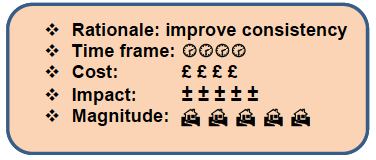
Possible Assessment action:
Clarify RdSAP conventions with regard to circumstances under which an assessor can / cannot choose to suppress automatic recommendations taking account of a householder’s circumstances.
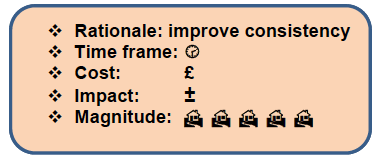
6.2.2 Reference Values and costs within the Product Characteristics Database
Issue:
The current PCDB does not meet Scottish needs: it is too generic and too inaccurate to assist owners and occupiers in making informed investment decisions on how to improve the energy efficiency of their property.
Analysis:
The capital costs quoted on the EPC for installing potential improvement are fixed within the PCDB, and are often presented as a cost range rather than a specific cost, and in some instances, a very wide cost range. They are intended only to be illustrative in the broadest sense. Accordingly, these costs do not vary across the country. The costs do not vary on the basis of known building characteristics such as the size of building, or whether it is a flat or house. For example, cavity wall insulation is presented as the same price regardless of the area of wall that can be treated, even where this information is known within the model as it calculates the external wall area. The costs do not account for preparation costs, meeting health and safety requirements or additional occupant costs e.g. decanting and redecoration. The costs do not account for planning or building warrant permissions where these are required. Estimated costs presented in this way are not helpful to either the building owner or the occupier, and may misrepresent both the size of the investment required and the potential savings and paybacks.
Whilst the PCDB data is reviewed regularly, and the date of review is visible for each improvement cost, it appears that the costs are not reviewed very frequently[103]. It is not possible for the assessor to input local costs into the calculation. This inflexibility was a protection for the loan calculation known as the ‘Golden Rule’ under the Green Deal, and a protection against unscrupulous salespeople misrepresenting the benefits of their wares. This same inflexibility could act as a point of contention for assessors providing EPC services to landlords and home owners in the future where investment decisions are being made on the basis of information on the EPC to meet specific EPC standards or targets.
For reporting capital costs of measures, this needs to be an area where the assessor can provide a localised price if this is known, and that it should consider the variance of price by the proportion of the property being treated.
In addition to this, the annual savings stated, whilst better than a general range, may be better valued if they were in some way reflective of the occupant’s behaviour and circumstances.
While RdSAP takes account of local Scottish climatic variables when assessing the impact of improvements, it does not take account of Scottish fuel prices. The PCDB uses national fuel prices that are updated every six months. However, the average costs for electricity and gas supply in Scotland are already collated by Ofgem and reviewed every 6 months[104]. Why not embed these prices into the PCDB, so that the reported savings are not only based on the local climate but local fuel prices as well?
Possible Assessment action:
Enable and allow assessors to modify the PCDB costs for improvement works, allowing the reporting of capital costs of improvement measures to be made more specific to the community where the works would be carried out.
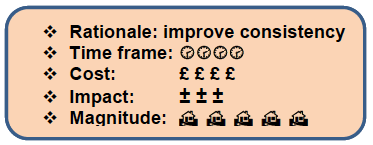
Possible Assessment action:
Allow variations in the costs of the works proportionate with the percentage of the property being treated.
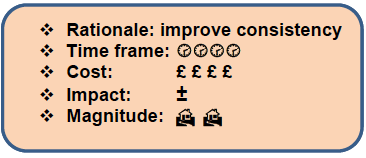
Possible Calculation action:
Establish a Scottish PCDB reference database to allow for Scottish-based inputs such as fuel costs and improvement costs, to calculate the EPC outputs on the EPC such as the savings on fuel costs, and the paybacks.
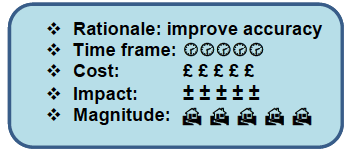
6.2.3 Meeting Minimum Standards
Issue:
The current EPC reporting format does not allow for target setting, nor does it explicitly link to policy targets (e.g. EESSH) which utilise the EPC rating.
Analysis:
The role and purpose of the EPC is evolving: what was an asset rating for the purposes of sale or rental of properties is becoming a tool in regulation and compliance.
EESSH currently sets energy efficiency standards for social landlords to comply with by 2020, and the Scottish Government is currently consulting on their successor. The PRS consultation proposed minimum energy efficiency standards with the intention that these would become more onerous over time. As an RdSAP data entry item is the tenure, and distinguishes between private and social landlords, this information could be used to inform the recommendations presented on the EPC.
As the announced intention of the Scottish Government is to increase the minimum standards over time, just meeting the minimum energy standard now may not be sufficient in a few years’ time.
Building owners should be encouraged to go further to prevent repeated phases of improvement in the future. However, there is a downside for landlords, as good as they may want to be: it is difficult to maintain standards when factors that influence RdSAP are not controlled by the building owner (e.g. occupant actions can impact on the assessment for an EPC, e.g. low energy lighting can be removed, loft insulation can be disturbed, electricity meter types changed when switching supplier which may all impact negatively on the EPC rating).
The duality of purpose could be achieved through the recommendations and advice report running in parallel with the asset rating. A duality of purpose already is embedded within the EPC as the SAP rating and fuel costs use two very different cost and climate bases, so this could be extended to the EPC report as well.
Possible Reporting action:
In order to avoid significant material changes to the EPC as required for EPBD, consideration should be given to a separate associated energy efficiency advice report or improvements report. This report would be both methodologically and administratively linked to the EPC itself.

6.2.4 Recognising New Technologies
Issue:
New technologies are not well accommodated for within the EPC process.
Analysis:
Driving innovation and finding new solutions to tackling difficult problems requires a significant amount of support, both financial and also by way of recognition of the impact of such measures.
SAP is primarily an evidence-based model. Introducing new products within an existing class of measure can be a simple matter of obtaining the certification of performance under an agreed methodology of testing e.g. a new more efficient boiler will follow the EU guidance on testing to obtain efficiency data which can be included in the PCDB: the standards are agreed, the testing method and procedures agreed, and the procedures for updating the PCDB established. When a new product or technique appears that is outwith the agreed protocols, then the only possible route is by empirical and peer-reviewed research to validate the claims, and to determine a new method or algorithm to integrate into the existing SAP methodology. In some cases the technological change may even demand a revision of the underpinning BREDEM.
As technological innovations can occur faster than changes in calculation methodologies, a process known as Appendix Q[105] was introduced at the time with SAP 2005 as an interim route into SAP: the Appendix Q process could be used to include a new technology before an update to the underlying SAP model. The software allowed for the impact of improvements calculated through the Appendix Q process and entered into the calculation. The assessment of heat pumps and mechanical ventilation heat recovery systems were developed through the Appendix Q process.
The intention was that Appendix Q would be an evolving process, so that a new technology assessed in Appendix Q in one iteration of SAP (e.g. SAP 2009) would become embedded in the next (e.g. SAP 2012); it would subsequently be incorporated into RdSAP. Unlike the full SAP program, there is no facility for Appendix Q calculated savings to be input into the RdSAP software. As the primary route for EPCs in existing homes is the RdSAP methodology, this means that, in practice, Appendix Q cannot be used for this purpose.
The problem with trying to short cut the process of gathering empirical data on new technologies and the process of validation is that many new technologies are also accompanied by claims that cannot be substantiated by rigorous testing.
The current model for lighting energy does not differentiate the savings impact of light emitting diode (LED) lighting over that attributed to compact fluorescent lighting (CFL). Whilst both are ‘low energy’ compared to traditional incandescent lighting, LED technology does confer additional savings on top of those provided by CFLs.
A completely different aspect of new technology is the development of new in-situ non-destructive testing processes which are not utilised fully in the assessment process. Infra-red technology can provide valuable data to tackle thermal bridging, and air pressure testing can actually be directly utilised in SAP but only full SAP, not within RdSAP. Air pressure testing is discussed in more detail in Section 6.8
Possible Assessment action:
Amend the RdSAP software to allow for the inclusion of Appendix Q calculated savings for technologies not currently incorporated in RdSAP, following the same guidelines that are currently applied to using such procedures in SAP.
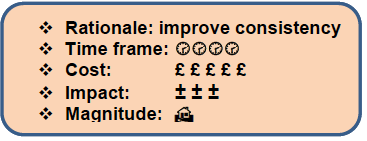
Possible Calculation action:
Amend RdSAP procedures and software to differentiate between CFLs and LED with regard to assessing lighting energy consumption, and potential savings.
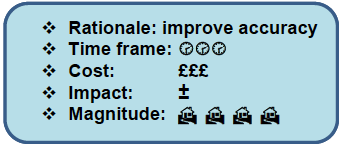
Possible Calculation action:
Allow the inclusion of in-situ test results such as air pressure testing or U-value measurements to be included in the RdSAP assessment of existing properties. Such procedures are already defined in SAP for dwellings.
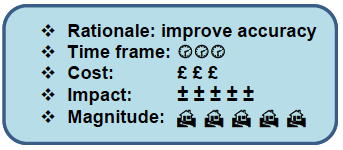
6.2.5 Occupant Behaviour and Recommendations
Issue:
Occupant behaviour is not accounted for within the standard SAP, RdSAP and SBEM methodologies, and their recommendations.
Analysis:
As an asset rating of a building, the assessment process is not concerned with how the occupants use the building, which can impact on actual fuel costs, energy consumption, emissions, and potential savings quite significantly. With the move towards using the asset rating for compliance and regulation purposes, the EPC outputs could be better utilised within a minimum standards assessment and to better inform the building owner or occupier.
Again, the recent experience of the Occupancy Assessment within for the Green Deal Advice Report provides a precedent on how this may evolve. The OA was separate, detailed assessment of the household along with a consideration of a wider array of improvements than available with RdSAP. However, it was built upon, and informed, by the EPC assessment, which had to be completed first.
In order to avoid significant material changes to the EPC as required for EPBD, consideration should be given to a separate associated energy efficiency advice report or improvements report. This report would be both methodologically and administratively linked to the EPC itself.
Possible Reporting action:
Use the EPC data to provide tailored advice and support to householders by developing a parallel reporting process.

6.2.6 Format of the ‘Recommended measures’ table
Issue:
The format of the ‘Recommendations’ table is not easily understood (e.g. the mix of cumulative impacts to the SAP rating reading down the table in one column and the impact of individual measure effects provided as a cost saving (£/year) in another column of the same table).
Analysis:
Many respondents felt that the savings calculated for the application of potential improvements do not reflect reality: the costs were not real, while the fuel costs do not take account of the actual occupants or their use of the home.
The list of recommendations on an EPC is neither a job sheet for planned works, nor is it a design specification. Some workshop respondents highlighted that some occupants perceive the EPC to be a quotation for work or ‘price promise’ or a guarantee of reduced fuel costs. The description of improvements should be sufficiently generic, and come with an explicit note requiring the need for more professional consideration and specification. It is particularly important to communicate the factors which may introduce a deviation from the expected performance i.e. the ‘performance gap’.
The ‘performance gap’ is widely recognised as an issue for the industry and is being tackled in some way through the PAS 2030 and PAS 2035 (Quality Mark) certifications.
The format of the recommendations section of the EPC needs to be reviewed to fit its purpose, providing easily understood data for a public who are not built environment professionals.
Possible Reporting action:
A consumer review of the EPC format is needed in order to revise the way that information is presented on the document so that it is understandable by the householder, and not just a technical audience. The review should consider information such the values and terms used and what these mean to the consumer. The certificate itself is an authorised legal document; however, the information contained within certain sections is indicative and not an approved schedule of planned works.

6.2.7 Inappropriate Recommendations
Issue:
The recommendations on the report are inappropriate for traditional buildings.
Analysis:
It is widely recognised that older vapour permeable structures need to remain well ventilated in order for interstitial moisture to naturally evaporate. The application of modern insulation materials which encapsulate the building, creating a vapour impermeable barrier can, over time, affect the integrity of the structure within and also contribute to an increase of moisture levels within the home i.e. affecting both the occupants and the building.
In all buildings, whether vapour permeable (e.g. sandstone) or vapour impermeable (e.g. concrete), the impact of insulation improvements on the ventilation of the dwelling must be taken into consideration. PAS 2030 accredited installers should be working to a method which minimises the ventilation impact of improvement measures. Where an improvement requires a building warrant, this needs to take regard of the impact of the measure in relation to Section 3 of the Scottish Building Standards. In practice however, it is recognised that where this has not been addressed, that the internal environments can become damp without significant occupant intervention.
For historic buildings and those with protected listing status, certain types of fabric improvement to buildings can obscure or even destroy internal and external features which are an important part of our built heritage. Where the need for such protection/conservation is clear it should be reasonable for assessors to exclude certain recommendations on the grounds of aesthetic or cultural heritage damage.
That said, as already noted above, the list of recommendations on an EPC is neither a job sheet for planned works, nor is it a design specification. Providing detailed design specifications is outwith the scope and purpose of an EPC; however as the data is captured at the point of assessment, this could be utilised to present cautionary messages to the occupant about the risk of these consequences.
A supplementary professional survey separate to the EPC was suggested in several responses, even going as far as to say that the recommendations section should just be removed from the EPC as it can be misleading and unhelpful.
It was already discussed in Section 6.2.4 above that the assessor is not in control of the recommendations on the EPC as these are a direct consequence of the software and Appendix T. It was also recommended as a possible action that the guidance on when an assessor can and cannot suppress a recommendation be revised. That recommendation is reinforced here.
Possible Reporting action:
Amend the wording on the EPC with regard to recommendations for specific construction types, that more additional expertise is needed. This could be done achieved through the assessor selecting an addendum item for the need for professional expertise with specific construction types.

6.2.8 Building Condition
Issue:
The EPC assessment does not take account of building condition.
Analysis:
An EPC energy assessment is not a building condition assessment. Disrepair is an issue in the private sector, even just basic maintenance cleaning gutters etc. In addition, the awareness of the limitations imposed by listed buildings and conservation areas is poor, as is the scope of the Tenements Act and its role in enabling disrepair works.
It is recognised through surveys such as the Scottish House Condition Survey that serious disrepair leading to moisture ingress etc. is a problem for some parts of the national building stock. There are often competing priorities for housing providers and, clearly, making buildings wind- and water-tight is a basic tolerable standard that should be addressed before any energy efficiency works.
Currently, the condition of the building is outwith the scope of EPC assessment unless it has implications for cavity wall insulation with regard to existing homes.
Before energy efficiency related improvements are carried out on a building, a condition report may be required to ascertain if any area of a building’s disrepair could have an adverse impact on the installation of an improvement, on its performance. A system to assess the health and safety of dwellings in Scotland, the Repairing Standard, operates in the private rented sector[106]. Again, with appropriate training an energy assessor could make an assessment on some elements of disrepair, and select an appropriate addendum within the data entry, which would add a note to the EPC.
Possible Reporting action:
Amend the wording on the EPC with regard to recommendations where the building is obviously not wind and weather tight that additional work may be required for the benefits of any improvement works are to be realised. This could be done achieved through the assessor selecting an addendum item for the need for professional expertise with specific construction types.

6.3 Topic: SAP and RdSAP Metrics
- Energy efficiency metrics and asset ratings
- Using real data
- Using Scottish data
- Occupancy factors
6.3.1 Energy efficiency metrics and asset ratings
Issue:
The presentation of properties on a rating scale (A – G) banded metric is a widely understood way of expressing progression from poor (G) to good (A). However, the basis of, the purpose of, and the value of the other data on an EPC is less well understood.
Analysis:
As a metric, SAP is not consistent over time. Changes to the methodology mean that every time the version of SAP changes a new scale evolves. This can be seen in the results of the Scottish House Condition Survey, with a drop in the mean SAP score after the introduction of a new version. For example, changes to the heat loss characteristics of party walls introduced in December 2014 as part of SAP 2012, resulted in SAP scores for mid-terrace houses falling by about 4 SAP points. Using a single SAP score as the basis of compliance means that a dwelling that just complies in one iteration of SAP may not when recalculated when the next one comes along. It may be more appropriate to use the SAP A-G bandings and recalibrate the banding scales going forward. That however, is beyond the remit of this report.
The SAP rating is an energy cost index. Fuel prices used in the SAP calculation are those hard coded into Table 12 in the SAP methodology[107], and for SAP 2012 and RdSAP, were derived from the 3-year national average fuel prices between 2011 and 2013 (so are well out of date). These embedded values only change with a revision of the underlying SAP model, so are not expected to be updated until the release of SAP 10.
To mitigate the impact of changing fuel prices over time, a correction is factored into the determination of the SAP rating[108] to correct for the “general rate of fuel price inflation”. As this correction is a single figure weighted by a population proportion of the main fuels used, it does have a tendency to mirror the cost of mains gas over time over any other fuel. In general terms, as mains gas price varies up or down other fuels normally follow this, so the correction factor is intended to keep the rating stable over time[109]. Where the cost of any particular fuel changes significantly differently to mains gas, then SAP ratings in these properties may vary over time. Better stability in the ratings over time would be achieved if the price correction for each fuel was measured against price changes for the respective fuel, and not be determined effectively by changes in mains gas prices.
Possible Calculation action:
The impact of the changing fuel prices on the SAP rating over time is accounted for in quite a blunt way within SAP and RdSAP. Rather than use an overall average fuel price index, a fuel price index for each fuel should be calculated and embedded with the SAP and RdSAP calculations. Going forward we can no longer have the confidence that all fuel costs will follow a similar trend or direction.
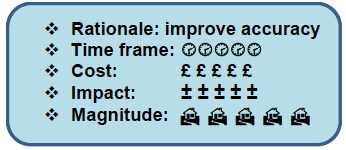
This impact of fuel prices on the SAP ratings resulted in the differential EESSH standards for social landlords for the different dwelling types depending on the primary heating fuel. Lower target scores were set for electrically heated dwelling types. Further, the target scores were revised for all electrically heated dwelling types within the EESSH reference tables where the SAP score is calculated using SAP 2012 software, rather than SAP 2009[110] software. The impact of the energy cost deflator kept the ratings comparable between SAP 2009 and SAP 2012 for properties heated by mains gas. However, as the price of electricity had changed by a greater magnitude than mains gas over the same period, an additional adjustment in the policy target was required to ensure consistency over time.
Setting single targets that are effectively determined by the price of mains gas penalises owners and occupiers being that are reliant on other fuels, especially for space heating and hot water. This may be for no other reason than a property is located well off the gas grid. The proposals in the PRS consultation set single banding standards, and in the proposed timetable of making the banding more onerous, for private rented properties regardless of the primary heating fuel. Meeting these targets will be more difficult in off-gas grid areas.
Possible Reporting action:
Develop differential SAP targets for dwellings for different primary heating fuels.

The rating is also affected by the type of electricity meter[111] serving the property as identified by the assessor, but the actual electricity tariff applied is determined by the software not the assessor, and is dependent on both the type of electric heating and the meter[112]. Common Scottish electricity tariffs, such as ‘Total Heating / Total Control’[113], and ‘Comfort Plus Control’[114] are not offered by all electricity suppliers, and so a household may find their tariff has been changed to one that is very different in its price make up when they switched supplier regardless of the installed meter, or their meter may be changed, with unintended consequences on the SAP rating.
Landlords can install appropriate meters for the type of heating, and low energy light bulbs to ensure compliance with a SAP standard. Tenants can remove heating, switch tariffs, and replace low energy light bulbs with less efficient lighting; all to the detriment of the SAP rating.
Possible Reporting action:
Where the rating is subject to the type of metering (e.g. with electric storage heating) or the presence of low energy lighting, a note should be added to the EPC stating that switching tariffs or replacing the low energy lighting with less efficient lighting may have a negative impact on the rating to landlords and owners on the actions that can have an adverse impact on the SAP rating.

In terms of developing a new narrative for the energy information on an EPC and the general public, the assessment needs to make sense within the context of the use of fuel within the home. The EPC presents data in a way that appears obscure: running costs and potential savings are presented for a 3-year period. There is no built-in allowance for the possible changing of prices within this 3-year period, which seems unreal. For majority of people on salaries, this should be annual. For those on benefits, then perhaps monthly or even weekly may provide a better way to understand the purpose of this metric.
Possible Reporting action:
Adjust the presentation of fuel costs and savings to reflect annual fuel bills (not 3-year totals) and annual savings. There may also be some benefit of also including what the annual total converts to in terms of an average weekly fuel bill in summer and winter, to better inform householders.

Possible Reporting action:
Consider the value that can be added to the EPC process with a separate occupant report. This kind of approach could help to address the view that the EPC in itself should not fundamentally change; the data used to generate it could add significant value to a supplementary advice report which then brings into play specific occupant factors.

However, not everyone agrees that the existing EPC format should be further developed to accommodate an occupancy component within the rating or the EPC be customised to the occupant. A compromise position could be the adoption of a parallel process which maintains the current standardised format for the EPC to fulfil the EPBD, and a separate occupancy rating. This approach may also allow the assessment of the impact of energy amenity not related to the energy required for heating space, hot water, ventilation and the provision of adequate lighting.
The Scottish EPC for domestic buildings publishes an Environmental Impact Rating alongside the ‘Energy Efficiency Rating’ (i.e. the SAP score) which to all intents and purposes appears to be ignored in the policy context. Retaining both on the front page of the Scottish EPC may appear confusing to some, however it does support the operation of both social and environmental policy aims.
The development of greater Scottish renewable generation capacity is not reflected well in either the energy efficiency or the environmental impact metric. The EPC currently adopts a GB context for energy and associated emissions. With Scottish targets for emissions reductions, it follows that the EPC in Scotland should measure environmental impact against these targets using Scottish data. Some have argued that this should go further and that, just as we could adopt an occupant focus for a parallel report which aims to give a property specific operational rating on a domestic property, we could also extend that view to the emission rating, at the very least within a Scottish context or even a local distribution geography e.g. an emissions ratings for Orkney or Shetland respectively.
Possible Calculation action:
Review the financial benefit of embedded generation within the EPC process. Currently the SAP score on the EPC is improved with electricity generating renewables; however, it is not clear how this translates to an energy cost saving for the occupant.
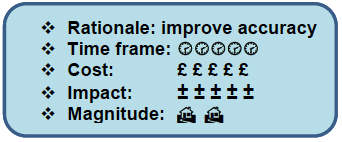
Despite the claim on the EPC, since the introduction of SAP 2012, the carbon dioxide emissions are not just but about CO2, but also include equivalencies for other greenhouse gases in the calculation. This should be clarified in the EPC wording.
Possible Reporting action:
Adjust the wording on the domestic EPC so that it refers to carbon dioxide equivalent (or CO2e) emissions rather than simply carbon dioxide.

6.3.2 Using real data
Issue:
Assessments of buildings should use real consumption data, and not standardised or modelled data.
Analysis:
SAP was developed using standardised reference values to ensure consistency in assessments, and to allow ratings to be comparable across the country.
As stated previously, confusion could result if using real fuel cost data had a direct impact directly on the EPC rating, as this would not allow the results to be comparable. Thus, the context for use of real data is likely to be a parallel report. In all cases though, the EPC should state the costs that have been used in the calculation, both modelled and real, with full disclosure of reference data.
In-situ measurement of a building’s thermal performance would be prohibitively expensive.
Conventional methods of collecting ‘real data’ are time-consuming, and expensive, and for an asset rating, unlikely to be valued or supported.
No further action
6.3.3 Using Scottish data
Issue:
Assessments of building should use Scottish specific data, and not standardised or modelled data.
Analysis:
SAP was developed using standardised reference values to ensure consistency in assessments, and to allow ratings to be comparable across the country. Over time, within the information presented on the EPC has evolved, so now only the SAP score, and the recommendations and their respective cost range remain nationally comparable. The use of local climate data within SAP coupled with national 6-monthly mean fuel prices results in two separate sets of calculations running in parallel: one to calculate the SAP and Environmental Impact scores, and another where reference values are kept under review and can change every six months to generate the other metrics on the EPC.
More specific Scottish data could be accessed through the current PCDB system and used for assessments in Scotland. Entering the post code / location into the software is already used to access the different defaults, e.g. in SAP and SBEM, the very different Building Regulations; in RdSAP, different reference age bands and default wall U-values. As already noted in this report, Ofgem collates Scottish gas and electricity prices on a 6-monthly basis, so Scottish average fuel prices could be built into the PCDB, and used instead of national averages. Oil costs across Scotland are quite different from the average in the UK. A simple adjustment to the climatic base of the SAP calculation, would allow a Scottish SAP to be calculated.
Additionally, a cost file editor similar to that available in the past within the NHER software system would allow improvements costs to be localised by the assessor manually, to the point of being able to provide bespoke reports on potential improvements. Extending this, again in keeping with facilities that were available in the NHER software, localised fuel prices or occupant-specific prices taken from the fuel bill could also be entered into the program, further allowing the report and recommendations to be customised owner or occupier’s circumstances without affecting the actual energy efficiency rating. Currently, an assessor is not expected to gather or localised costs, so this approach is likely to need an expansion of skills and competency.
This development could be done so as without affecting the actual energy efficiency rating.
Possible Calculation action:
Develop a Scottish PCDB which all approved software would use when generating Scottish EPCs. This would have data on energy efficiency improvements and fuel prices which reflect the Scottish market.
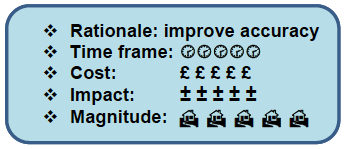
Possible Reporting action:
All data referenced from the PCDB to produce the various metrics on an EPC should be declared on the lodged document.
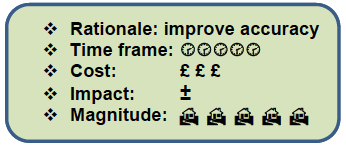
Possible Assessment action:
Publish a guide on calculated and tested U-values for non-traditional and ‘system built’ buildings in Scotland (this is set out in more detail in Section 6.1.11).

6.3.4 Occupancy factors
Issue:
EPC process does not take account of the differences in how dwellings are occupied and how energy is consumed.
Analysis:
Where the policy purpose of an EPC is primarily about improving energy efficiency in the building, the current asset rating approach is, with some adjustments to better reflect the Scottish built environment, a practical solution. If the intention is to engage with owners and occupiers to inform them of their fuel costs or environmental impact, then the EPC process needs to account for the differences in how buildings are occupied and how energy is consumed, beyond that included in the SAP rating.
Occupants affect energy consumption. An operational rating accounting for behaviour could be developed which an assessor selects in order to create the occupancy rating e.g. single occupancy working couple, elderly couple, 2 adults – 2 children etc. This could be further tuned with specific data where known.
A methodology akin to the Green Deal Occupancy Assessment process could be developed to assess real data impacts and to correct for the performance of measures. If EPC output can be affected by occupancy factors, then there will undoubtedly be confusion and perhaps even abuses, thus, keeping these functions separate appears a prudent way forward. EPC assessors will need to be upskilled, in the same way that GDOA were, to account for occupancy factors.
Possible Reporting action:
Use the EPC data to provide tailored advice and support to householders by developing a parallel reporting process.

6.4 Topic: Non-domestic Buildings
- benchmarking
- new technologies
- performance gap
- real data
- recommendations
- review & update
- alternative model
- surveyor skills
6.4.1 Benchmarking
Issues:
Benchmarking requires the availability of energy consumption data that can then be used to prioritise measures/actions.
Analysis:
It can be difficult to make comparisons between different sectors. Barriers to energy efficient retrofits (e.g. insulation) are more significant than for dwellings. A number of responses signposted to recent publication articles and methodologies from other countries. A preference was indicated for operational ratings rather than asset ratings and a suggestion made for funding of longer-terms measures for older buildings.
Benchmarking data can be useful though should be used with care as it is possible to inadvertently compare dissimilar buildings or situations. The use to which the data would be put would also need careful consideration, especially if, for example, used as a basis of comparison for funding purposes. The stated preference for operational ratings (as per Display Energy Certificates (DECs) in other regions of UK) would introduce additional areas of uncertainty in terms of occupant behaviour and occupancy periods. Non-domestic EPCs in Scotland already carry information on the rating that the building would have achieved if built to current building regulations standards (or if subject to the England & Wales ratings calculation) while those in England and Wales also carry information on typical ratings for building stock of the same type.
Possible Reporting action:
Include operational ratings on EPCs in addition to asset rating. Include more comparators (e.g. typical figures for building stock, or at least the building archetype).

6.4.2 Real Data
Issue:
Local authorities should publish real-time data showing energy consumption in their buildings to provide a resource for benchmarking.
Analysis:
Energy consumption data is widely collected and available within local authorities and could be made more widely available. Many public buildings are required to display EPCs though in Scotland these are still asset ratings rather than operational ratings as applied to public buildings in the rest of the UK.
Possible Data Base action:
Produce and publish a database of EPCs and operational energy consumption
for all public buildings in Scotland
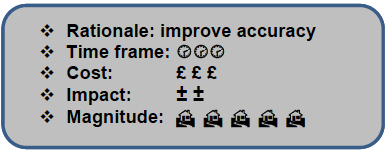
6.4.3 Performance Gap
Issues:
It is difficult to compare energy efficiency and heat decarbonisation performance between different commercial buildings.
Analysis:
EPCs refer to building energy only and not, for example, process energy or electric car-charging points. EPC recommendations cannot simply be translated into costs and actions and enhanced energy audits are needed.
Respondents raised the issue of the disparity between estimated energy consumption (as calculated by SBEM and represented on EPCs) and actual energy consumption of buildings. This is explained by a number of factors including: assumptions and estimations within the SBEM model that are not borne out in reality; the fact that SBEM does not take into account all energy end-loads in a building (e.g. process energy); in short, the differences between an asset rating (for the building) and an operational rating.
Possible Assessment action:
Require more detailed energy audits as the basis for funding decisions.
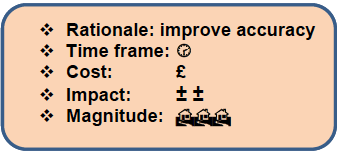
Possible Reporting action:
Publish operational as well as asset information on EPCs.

6.4.4 Recommendations for Non-domestic buildings
Issues:
A robust business case requires actual performance data and real costs.
Analysis:
Requirements for mandatory carbon reporting are trigger point for the energy performance assessment and budgeting. There can be a significant difference between EPC recommendations and guide costs and viable works and costs once on site. Where an ESOS report has been produced this may provide more reliable figures for potential energy savings but does not cover capital costs.
An EPC should not be used as the basis for a works specification especially regarding capital costs. Normal practice would suggest that at least 3 quotes should be obtained for capital works. The non-domestic EPC however should be more reliable in terms of recommendations than the domestic equivalent as the non-domestic assessor is able to add, edit and remove recommendations as they see fit.
This issue has, in part been addressed through the introduction of the Action Plan required where buildings are subject to the Assessment of Energy Performance of Non-domestic Buildings (Scotland) Regulations 2016. The Action Plan requires a ‘Section 63 Advisor’ to produce a list of tailored recommendations for improvement of a building subject to these regulations. This additional process recognised the limited benefit that can be derived from the generic recommendations that accompany the vast majority of non-domestic EPCs and the need for further advice if considering improvement.
Possible Reporting action:
A note should be added to the EPC that EPCs should not be used as the basis for works specifications or costs without further more detailed assessment.
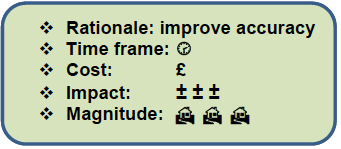
6.4.5 Alternative Models
Issues:
There are many commercially available dynamic simulation models that can be used to assess the energy performance of new and existing non-domestic buildings.
Analysis:
While it is certainly the case that alternative models exist, including dynamic thermal models, this is out with the scope of this report.
No further action:
Alternative models were not within the scope of this report, though they may be a worthy subject for future consideration.
6.4.6 New Technologies
Issues:
SBEM is behind the times with regard to new technologies.
Analysis:
The SBEM model on which most non-domestic EPCs are based can represent new technologies such as solar PV, solar thermal, wind, biomass, biofuels, CHP, transpired collectors, waste heat recovery, though not micro-hydro, nor free cooling technologies.
There is certainly scope for enhancing SBEM to be able to cater for such technologies though this would probably require edits to the methodology as well as the interface and would be outwith the scope of this report.
Possible action:
Contact BRE/UK Government department to determine whether there are any plans to increase the range of new technologies catered for in SBEM.
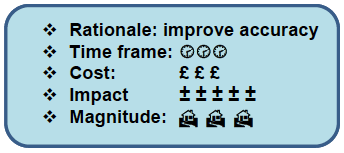
6.4.7 Review and Update
Issues:
The current concept of EPCs is sound, as is that of DECs using real data – should they not be combined into one certificate in the future.
Analysis:
There is a consensus of opinion from the workshops that EPCs for existing buildings should include an operational rating as well as an asset rating. It appears to be confusing with the introduction of the Section 63 requirements that there will be 2 very different rating certificates on some non-domestic buildings. The rationale was that the headline figures would more closely represent actual operation of the building which could be important if, say, the EPC were being used for estimating savings/grant eligibility etc. The asset rating is still useful in being able to make a comparison between different buildings of the same type on the same basis.
Combining the asset and operational ratings would require amendments to the interface and output though minimal amendments to the methodology.
Possible Calculation action:
Amend the EPC generator module to allow input of operational energy data such as used in DECs in other parts of the UK.
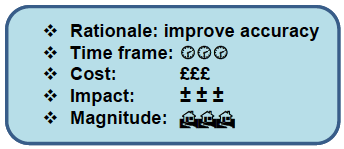
6.4.8 Surveyor Skills
Issues:
Non-domestic assessors need a higher skill set that domestic building assessors because of the size and specialist purposes of many non-domestic buildings.
Analysis:
This is a positive observation as it means non-domestic assessors are more likely to be suitably experienced and trained in the use of the software and production of EPCs. There were no negative consultation responses regarding non-domestic assessors.
No further action.
6.5 Topic: Assessors
- Starting point
- Surveyor skills
- Quality assurance procedures
- Quality assurance: consistency
- Integrity
- Independence
- Accountability
- Quality Assurance: Improvements
6.5.1 Starting Point
The starting point here was the public expressions of concern across a range of issues involving Assessors. These issues were less about technical concerns with the methodology or the software and more about gaps in the Quality Assurance processes and questions about the competence and independence of assessors. These issues are integral for public confidence and its buy-in to the EPC framework – assessors have to be seen as skilled and independent, the quality assurance procedures have to be seen as robust and consistent in the outcomes, and the system has to be accountable.
6.5.2 Surveyor Skills
Issue:
Respondents raised concerns about the level of training and qualifications of EPC assessors, and noted that there should be a higher level of qualifications and accreditation of assessors.
Analysis:
The high number of responses pertaining to surveyor skills identified in this project was in part a direct consequence of the format of the PRS consultation document: the consultation specifically included questions about surveyor skills and the need for additional qualifications[115] - 144 of the 206 responses identified here were directly related to replies to these questions. The broad consensus of the PRS consultation responders (i.e., 71% overall and 86% of those responding to this question[116]) was that it would be useful to have a traditional buildings qualification on energy efficiency. On traditional buildings, it is not that additional qualifications and courses do not exist already[117], rather it is more the issue that there is currently no requirement for a person to gain such qualifications under current accreditation schemes to qualify as an EPC assessor.
There are two separate issues to address here. The first issue concerns whether current EPC assessors are sufficiently skilled to do the existing job. They should be - the accreditation schemes have all signed protocol agreements with the Scottish Government that include for the training and certification of assessors, Continuing Professional Development training, and quality assurance monitoring that are intended to ensure that current EPC assessors meet a minimum skill standard. Certainly, the consultation responses indicate they are less than convinced that this is the case. During the workshops, a number of participants cited anecdotes of lodged EPCs that failed to correctly identify building components or reflected a lack of care during the survey. Possible actions to address this issue will be explored below under the issue of quality assurance procedures.
The second issue raised concerns that in going forward with promoting energy efficiency as a national infrastructure priority there was a need to develop further skills. The Scottish Government could promote the development of a higher qualified, broader skilled, more professional EPC assessor generally. This approach could include more than additional qualifications on traditional buildings, for example, including a number of additional modules on other building constructions, renewable technologies, insulation specifications, and sizing heating systems amongst other modules. As part of this development, regulation of EPC assessors could move from the various accreditation schemes to one professional body, for example, an EPC assessor associate membership of RICS. This development could be phased in over several years to allow existing surveyors to upskill and meet the new accreditation requirements.
Possible Assessment action:
Explore with SQA and RICS the development of a higher-qualified, broader-skilled, more professional EPC assessor.
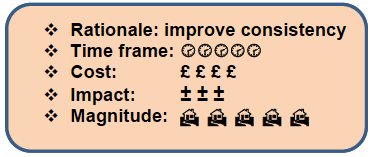
6.5.3 Quality Assurance Procedures
Issue:
Respondents felt the current system of quality assurance checks completed by the accreditation schemes in Scotland is inadequate to ensure that a consistent and accurate EPC rating is being achieved by anyone who carries out an assessment.
Analysis:
In Scotland, the Scottish Government set the overall framework with regard to production of EPCs and entered into formal protocol agreements with a number of accreditation schemes (known as Approved Organisations). It was left to these Approved Organisations to set the requirements for their members with regard to quality assurance procedures, amongst other things. While the specific arrangements vary, the different schemes more or less follow the same process: for EPC assessments selected for quality assurance checking, the assessor is requested to submit the supporting documentation which is then checked by the accreditation scheme. This check is a completely desk-based exercise, and is good as far as it goes for correcting visible mistakes in the survey or the data entry, or the interpretation of conventions. While the assessor has to submit supporting evidence (e.g. photographs) of items included in the assessment, items that are missed out may never be picked up, because they were not included in the documentation. On-site, independent follow up assessments are not included as part of the EPC quality assurance procedures.
After a pilot study in 2016[118], ‘Smart Auditing’ was introduced in England and Wales on June 1st, 2018. This is a ‘risk based’ audit based on a defined set of rules, whereby an EPC is selected for audit if it breaches a ‘smart audit’ rule[119]. However, the ‘smart audits’ are still a desk-based exercise, and are not in addition to current accreditation schemes’ quality assurance targets, but will be included within their requirement to audit 2% of lodged EPCs.
The Sustainable Energy Agency of Ireland, which runs the equivalent to the Scottish EPC scheme in the Irish Republic, initially relied on desk audits to monitor 2% of assessors’ work. Concerns over the quality of completed assessments led them to introduce a national examination in national test centres on top of the training qualification (which has to be re-sat every two years), and the introduction of a system of external independent audits, with auditors going out on site to re-visit assessments or carry out assessments in tandem with assessors. This audit scheme includes penalty points; the more serious the mistake the more penalty points imposed, with 12 points incurring a suspension, and multiple suspensions revoking registration. The combined result of the repeated national examination (and the associated cost of sitting the exam) and the independent auditing has resulted in a significant drop in the number of registered assessors in Ireland[120].
Requiring independent back checks would be in keeping with other schemes where quality assurance is considered paramount. Under the Scottish House Condition Survey procedures, independent back check surveys are carried out on a percentage of every surveyor’s work as part of the quality assurance procedures. Originally 5%, the percentage has dropped with the introduction of other data validation systems. Under ECO, ECO2 and ECO2T, Ofgem required the utilities to include an independent re-inspection of at least 5% of all jobs, not only to ensure the quality of the work completed, but also on the initial survey data.
Possible Assessment action:
Undertake a research exercise to determine how many EPCs issued under RdSAP 2012 v9.92 breached the ‘smart audit rules’.
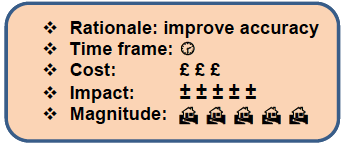
Possible Assessment action:
Introduce ‘smart auditing’ as part of the Approved Organisations’ quality assurance targets in Scotland.
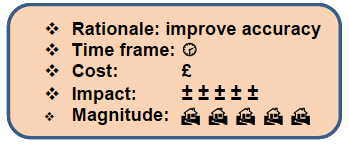
Possible Assessment action:
Introduce the requirement that the quality assurance procedures include independent on-site re-inspections.
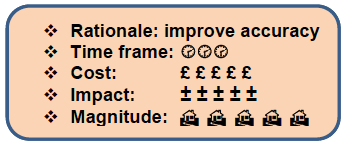
Possible Assessment action:
Establish an independent regulator (or vest it within Scottish Government) to oversee the independent re-inspection of EPC assessments, and to report annually on the results.
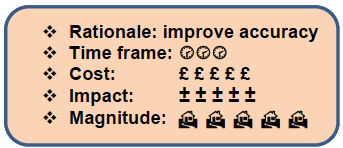
6.5.4 Quality Assurance: Consistency
Issue:
Different assessors give different results.
Analysis:
Within RdSAP, it is conceivable that different assessors could produce SAP scores for the same property that did not match, or that the same assessor could produce varying SAP scores for the same property. Within RdSAP, there are some data inputs that allow the assessor discretion over whether to use the defaults within the methodology or to input more detailed information (e.g., as discussed in Section 5.5 on rooms in the roof and Section 5.8 on windows). There are also a few items where there is a degree of subjectivity (e.g. whether the kitchen is a habitable room or not). Assessments need to be shown to produce the same, or at least very similar, results, regardless of the assessor involved. This level of assurance will be even more important if associated with financial incentives for energy efficiency improvements and/or regulation to minimum standards of energy efficiency.
If the results are markedly different, then something is wrong. As with the quality assurance procedures discussed above, the Scottish Government has left it to the accreditation schemes to set their requirements with regard to qualifications, including the requisite training. There is no single training standard applied to EPC assessors in Scotland. Unlike England and Wales, and the Irish Republic, there is no ‘national examination’ for EPC assessors either.
A large number of workshop participants supported the need for a single recognised standardised qualification to be implemented in Scotland, rather than the variety of different training schemes and qualification standards promoted by individual approved organisations; one training course – one qualification, with on-site visits, based on National Occupational Standards that accurately reflected needs of the vocation and working in the Scottish dwelling stock.
Possible Assessment action:
The Scottish Government in conjunction with SQA to identify and introduce Scottish qualifications, based on National Occupational Standards, for EPC assessors, for existing dwellings, new build dwellings, and non-domestic dwellings. Part of this qualification would be the potential assessor successfully completing a national examination.

Possible Assessment action:
All SAP, RdSAP and SBEM training courses being offered in Scotland, and the respective trainers, should be vetted with regard to their competence and the experience of the trainers. These items should not be left in the hands of the accreditation Schemes.

6.5.5 Quality Assurance: Integrity
Issue:
Respondents raised concerns about the integrity of some EPC assessors with a perception that they may be deliberately changing data or making recommendations for financial gain.
Analysis:
There is a significant degree of difference between a situation where an assessor makes a mistake and misses out some control or wrongly identifies a wall construction, and that where an assessor or company routinely or deliberately misrepresents the data for financial reward. If the quality assurance procedures are adequate then ‘honest’ mistakes will be picked up and corrected, and the assessor will learn. If data is being misrepresented routinely, then the quality assurance procedures may pick up the issue, but as the quality assurance procedures are only 2% desk audit of EPCs, an unscrupulous assessor or company may accept that this risk is financially worthwhile. For some types of misrepresentation, for example claiming a filled cavity wall as unfilled to attain a better carbon saving and a higher profit from [supposedly] filling it, may be facilitated by not submitting any photographs showing an existing drill pattern as part of a quality assurance audit.
Where repeated misrepresentation of data is found, sanctions exist so that assessors or companies can be suspended or ultimately de-registered from the EPC process. The Department of Energy and Climate has suggested with regard to the Green Deal, “that as many as 11% of Green Deal assessors and 14% of Green Deal installers were suspended by the change due to ‘non-compliance with Green Deal scheme requirements.”[121] However, respondents felt that these sanctions are seldom used (if at all). As one workshop participant noted “In the insulation industry I have not heard of any EPC assessor or PAS2030 contractor being suspended or losing their accreditation or being fined” – name and shame.
Possible Assessment action:
The Scottish Government to agree with the Accreditation Schemes rules and procedures for suspending and de-registering assessors or companies that bring the EPC scheme into disrepute by misrepresenting data, and the list of suspended and deregistered are published as part of the list of registered assessors online.

6.5.6 Independence
Issue:
There is a conflict of interest with insulation companies carrying out EPC assessments that recommend the products they are selling.
Analysis:
Currently, there are no rules preventing insulation companies employing EPC assessors. The recommendations included on the EPC are a direct consequence of Appendix T (see section 5.3). An assessor can remove recommendations from the EPC. However, unlike the Green Deal and the Green Deal Advisory Report, an EPC assessor cannot add recommendations to the EPC report. The EPC assessor could not change the order of the recommendations or the payback return on the EPC. All of these items are governed by Appendix T or embedded within the PCDB which are beyond the scope of the EPC assessor to edit.
Currently, as part of the lodgement of an EPC, the assessor is required to indicate any third party interest, though working for an insulation company is not one of the categories currently that must be declared. Unless this is seen as a problem, then no further action is needed.
No further action.
6.5.7 Quality Assurance: Accountability
Issue:
There is no mechanism in place to allow a home owner or landlord to challenge an EPC assessment.
Analysis:
In the current EPC format, there is only a summary of the information about the dwelling assessed included in the EPC report. If a householder or landlord is unhappy with the EPC rating, or believes that the data used in the assessment is incorrect, this mistake might be quite obvious, e.g. where the type of heating is completely wrong. In many instances the EPC report does not provide enough detail to confirm or disprove this belief. For the sake of transparency then, the survey data used in the assessment should be made available to the householder or landlord.
One method of doing this would be to reformat the EPC to include the input data, and possibly photographic evidence. An alternative approach would be to not only upload the EPC onto the national register but also the summary data. As far as the authors are aware, all of the approved EPC software packages for use in Scotland produce a summary report of the data included in the assessment. This summary report could be uploaded into the national register at the same time as the EPC is lodged, and the summary report could be made available online alongside the EPC report.
Possible Data Base action:
Require the summary data report to be lodged on the national register alongside the EPC, and to make this summary report available online alongside the EPC.

6.5.8 Quality Assurance: Improvements
Issue:
There is no system of quality control on the improvements carried out on a property as a result of an EPC recommendation.
Analysis:
An EPC may make a recommendation but the quality of any resultant works completed is an issue for the building owner or landlord and the installer and the various certification schemes governing the work. This concern falls outwith the scope of EPCs.
No further action.
6.6 Technical Issue: Room in the Roof Dwellings
- Starting Point
- The Use of Defaults: Consistency
- The Use of Defaults: U-values
- The Use of Defaults: Accuracy
- Cost of Improvements
6.6.1 Room in the Roof Dwellings: Starting Point
The starting point for examining the treatment of rooms in the roof within RdSAP was expressed concerns that the rooms in the roof within dwellings are not reliably accounted for within the EPC process. These concerns touched upon the collection of data on the room in the roof (i.e. the assessor consistency), the modelling of the energy performance (i.e. defaults, U-values, and accuracy), through to the costing of improvements recommended on the EPC (i.e. the use of the PCDB). There is a great deal of overlap amongst several of these issues.
6.6.2 Room in the Roof Dwellings: The Use of Defaults: Consistency
Issue:
It is left to the assessor’s discretion when to carry out detailed measurements of rooms in the roof, leading to inconsistencies between EPC assessments for the same dwelling.
Analysis:
Entering the dimensional data into SAP and RdSAP are two distinctly different processes. A full SAP analysis of a property requires the assessor to calculate the dimensional data for each fabric component within a dwelling, and to calculate the respective heat loss U-value for each different fabric component. While the full SAP methodology underlies RdSAP, RdSAP utilises a geometric model for calculating the fabric dimensional data, and defaults for assigning the U-values to their heat loss. As an asset rating, RdSAP is trying to combine accuracy and consistency through published conventions for assessors to follow when collecting the data, and when entering it into the approved software. The aim was to keep measurements as simple and straightforward as possible.
Rooms in the roof are a particular case in point. It was recognised that rooms in the roof could be complicated, and their measurement time consuming. In early field trials of RdSAP, wide inconsistencies were found amongst surveyors’ room in the roof measurements. As a result, algorithms were developed to calculate the room in the roof fabric components’ areas derived from the total room in the roof floor area. “Consistency was more important than accuracy[122]”. Between 2009 and 2012, RdSAP only required three data entry items: the age band of the room in the roof, its total floor area, and the thickness of any observed insulation.
In 2012, RdSAP was modified to allow for extended data entry for rooms in the roof, i.e. to be more in keeping with a full SAP assessment, as dimensional data and U-values could be calculated for each room in the roof fabric component[123]. The RdSAP Conventions were modified to define when the extended data option was required to be used for an assessment. For the most, few instances specifically required detailed measurements, and it was left to the discretion of the assessor to turn on extended data entry within RdSAP.
Recent changes to the wording of the convention on rooms in the roof (see Supplementary Topic Note 3 on Rooms in the Roof for further elaboration) has resulted in the text of Appendix S and the current conventions[124] not being consistent with one another. Further, the recent changes also appear to require more frequent measurements of roof rooms (again, see Supplementary Topic Note 3 on Rooms in the Roof for further elaboration).
The current convention reads:
“Detailed measurements of all elements are required only if evidence exists that the flat roof/slope/stud wall/gable walls have different levels of insulation or their U-values are known.”[125](emboldment added)
Given that many RdSAP assessors are not qualified under the RdSAP conventions to over-write the default U-values within the software, the caveat that detailed measurements are only required if the U-values are known limits the number of occasions when detailed measurements will be required. By contrast, the various components of the room in the roof often have differing levels of insulation. Are detailed measurements required in these instances? If so, then this requirement will significantly increase the number of occasions when detailed measurements are required, defeating the aim to keep measurements as simple and straightforward as possible.
Views expressed by workshop participants reflected the confusion amongst assessors:
- “that the guidance is not clear – unambiguous procedures need to be provided”;
- “the [Rd]SAP guidance and accreditation schemes guidance not clear enough on what measurements and inputs that are required”;
- “too complicated to understand when to measure”;
- “more definitive definition of … what exactly is to be measured”
Nobody stated that the guidance and conventions were clear and unambiguous.
Possible Assessment action:
The convention on rooms in the roof should be re-written to provide clear, unambiguous and definitive guidance on when detailed room in the roof measurements are required.

6.6.3 Room in the Roof Dwellings: The Use of Defaults: U-values
Issue:
RdSAP does not adequately account for the heat loss through rooms in the roof.
Analysis:
The U-values assigned to the individual room in the roof components in RdSAP are a function of the period when the room in the roof was constructed and the levels of insulation that can be identified during the survey. The resultant default U-values are defined in Appendix S of the SAP Manual.
Unfortunately, the requirement for evidence of the levels of insulation of the different room in the roof components is often denied to assessors by the very construction of the room of the roof: the level of insulation cannot be seen. Without requiring intrusive surveys, default U-values are needed in many room in the roof assessments.
While default U-values may be appropriate for ‘uninsulated’ rooms in the roof, or those constructed to a specific set of Building Regulation standards, it may not be sufficient for refurbishment improvements. Insulating a room in the roof is one area where, when the work is completed, visible evidence may not be available. As already discussed in section 5.2.14 above, the EPC process needs to develop to take account of insulation improvements where visible evidence is not available on completion of the works.
Possible Assessment action:
Develop procedures to take account of insulation that cannot be seen. This could include adding an addendum to the data entry that the U-values take account of insulation that has not been accompanied by the current standard of documentary evidence.

Possible Assessment action:
Develop a household log book akin to the benchmark log book for boilers in which contractors would sign off insulation improvements completed in a dwelling.

Possible Data Base action:
Develop a database alongside the EPC register to upload PAS2030 certificates of compliance that can be accessed by householders and assessors to check if insulation has been installed.
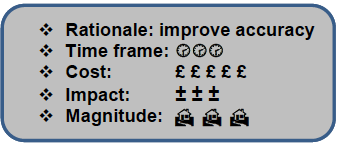
6.6.4 Room in the Roof Dwellings: The Use of Defaults: Accuracy
Issue:
Rooms in the roof are not reliably accounted for in RdSAP.
Analysis:
As discussed above in section 5.5.5, algorithms within the RdSAP methodology calculate the room in the roof fabric components’ areas from the total room in the roof floor area. The formulae effectively create a box room (see the Supplementary Topic Note 3 on Rooms in the Roof); the more the shape of the room in the roof deviates from this box shape, the greater the discrepancy between the actual component dimensions and those modelled.
One solution here would be to require full dimensional data for all room in the roof components. This approach has already been trialled and found wanting. An alternative approach would be to continue to utilise algorithms built into the RdSAP software to calculate the dimensional components but to have more of them[126]. Rather than entering only the total room in the roof floor area, the assessor would also select from the convention images the one that most closely matched the room in the roof arrangement of the surveyed dwelling, and the program would calculate the component dimensions. Importantly, this would also allow “half-wall” or 1.5 storey dwelling common walls to be treated differently from the stud walls built into the attic space (again, see Supplementary Topic Note 3 on Rooms in the Roof).
The workshop discussion revolved around whether there was ever a need for any dimensional measurements other than the total floor area. For many room in the roof structures, the impact of the extended data entry dimensions is marginal in terms of the rating. What appears to be more important is the level of insulation.
The presumption should not be that all roof room components are insulated to the same extent; the insulation of each component of the roof room structure should be identified and entered into the room in the roof data entry if possible. Like the main dwelling, this should be based on the thickness of the insulation that can be identified, and not from ‘calculated’ U-values. This would be consistent with the view expressed above that the “roof room data survey should be made more easy and repeatable”. More comparative work is needed on this topic.
If a more detailed energy assessment of a dwelling is required, and in particular, the roof room components, then an assessor could opt to enter extended data, but this would not be required for the asset rating.
Possible Calculation action:
Develop more algorithms for default room in the roof shapes. The conventions would need to be amended accordingly.
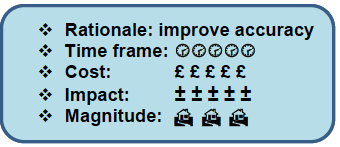
Possible Calculation action:
Redefine half-wall type dwellings within RdSAP. The conventions would need to be amended accordingly.
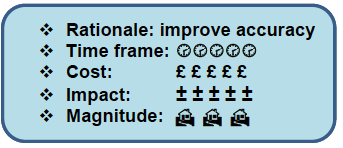
6.6.5 Room in the Roof Dwellings: The Cost of Improvements
Issue:
The costs associated with improving a room in the roof structure as shown on the EPC are highly inaccurate.
Analysis:
The costs associated with carrying out room in the roof improvements are embedded within the PCDB used by the RdSAP program. These issues are discussed more fully in Section 5.3.
No further action.
6.7 Technical Issue: District and Community Heating / Combined Heat & Power
- Starting Point
- Accuracy
- Use of Defaults
- Appendix T
- PCDB / Real Data
- Metric / Alternative Models / Mapping
6.7.1 DH/CHP Starting Point
The starting point of this topic was the concern that the benefits of DH/CHP are not fully recognised within the RdSAP methodology; and that methodological and software constraints in respect of DH/CHP need to be addressed if RdSAP is going to support DH/CHP and its role in supporting the development of local heat networks and shaping Scotland’s energy future by the year 2032.
6.7.2 DH/CHP Accuracy
Issue:
DH/CHP systems are not accurately accounted for within RdSAP. The input data associated with RdSAP is very limited.
Analysis:
In RdSAP, DH/CHP systems are entered into the software via only four considerations:
- the heat source: boilers / CHP / heat pump
- the system fuel: mains gas / LPG / oil / mineral oil or biodiesel / biodiesel from any vegetable source / biodiesel from vegetable oil only / B30D / coal / biomass / electricity / waste combustion / biogas / waste heat / geothermal heat source
- the main heating controls: none / programmer only / room thermostat only / TRVs only / programmer and Room thermostat / programmer and TRVs / two or more room thermostats
- the method of charging for consumption: whether flat rate charging or consumption-based charging
Significantly more system specific data is needed in a full SAP assessment. Compared to RdSAP, a full SAP assessment of the same systems would require data inputs on up to 10 variables (see Supplementary Topic Note 4 on Community Heating for a more detailed discussion on the data needs). The differences in the number of inputs are reflected in the outputs of the two programs.
A comparative case study (see Supplementary Topic Note 4 on Community Heating) comparing the differences in the outputs of a RdSAP assessment and a full SAP assessment of the same 13 flats[127], found that the RdSAP results ranged between 1 and 5 SAP points lower than those produced by the full SAP analysis; that RdSAP estimated fuel bills[128] were between £16 and £119 more over a year than those estimated by the full SAP assessment; and that RdSAP estimated CO2 emissions to be between 0.54 to 1.52 tonnes more per year that the full SAP assessment. When aggregated across the whole of the 55 flats within the multi-storey block, and compared to the full SAP assessment results, RdSAP over-estimated the CO2 emissions by 41,909 tonnes per year; over-estimated the fuel bills by £3,337 per year; and over-estimated the space heating consumption by 7,791 kWh per year.
The differences in the results between a RdSAP and a full SAP assessment of the same flats connected to a DH/CHP system suggest one of two possible courses: either incorporating the full SAP DH/CHP system data entry items into the RdSAP methodology, with appropriate conventions and defaults when the information is not available, or requiring a full SAP assessment when a dwelling is connected to a DH/CHP system.
Not all workshop participants were happy with either option:
- “I do not think that RdSAP is an appropriate tool for assessing DH/CHP schemes. DH/CHP should be investigated as a stand-alone exercise”.
- “Rather than fit DH/CHP into SAP or RdSAP, it may be more appropriate for future developments that SAP/RdSAP assessments are fitted into the models used by the major engineering companies to design DH/CHP schemes.”
- “DH/CHP affects a very small percentage of the Scottish dwelling stock: such a small number of properties are affected that it does not warrant a change”.
- Leave current average DH /CHP efficiency as is. I do not want to collect industrial sized boiler details.
Possible Calculation action:
Incorporate the full SAP DH/CHP system data entry items into the RdSAP methodology with appropriate conventions and defaults when the information is not available.
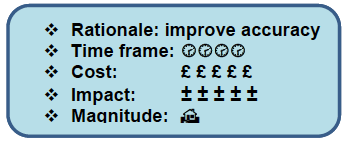
Possible Assessment action:
Require a full SAP assessment when a dwelling is connected to a DH/CHP system.
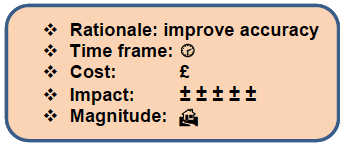
No further action:
Developing a stand-alone tool for assessing DH/CHP systems or incorporating the SAP / RdSAP assessments into the models used by the major engineering companies when designing DH/CHP systems - both have merit but are outside the remit of this report.
6.7.3 DH/CHP: Use of Defaults
Issue:
The RdSAP defaults for DH/CHP systems are very limited and poor.
Analysis:
In RdSAP, given the limited data inputs (see the section above); all DH/CHP schemes are assessed primarily from default data built into RdSAP. However, there would appear to be only one default for most of the data entry items, so that all DH/CHP systems are assessed on the basis of the same boiler performance efficiency and fuel prices, regardless of the actual age, efficiency, distribution network, or system fuel. The only item that has variable defaults is the CO2 emission factor(s) for the DH/CHP fuel source.
If a householder replaces a gas boiler in their home with a more efficient one, then the presumption is that the SAP score improves, but not so with DH/CHP systems. Replacement of ancient DH/CHP boiler plant with modern, more efficient plant has no effect on the SAP score. Not even changing the fuel source for the DH/CHP systems affects the SAP score, unlike switching fuels on individual heating systems. The estimated fuel costs are the same regardless of the fuel source of the DH/CHP system. This is demonstrated in Supplementary Topic Note 4 on Community Heating.
Neither the overall EPC result nor RdSAP outputs are reflective of the actual DH/CHP system installed. This further reinforces the need set out in the section above for either incorporating the full SAP data entry items into RdSAP, or to require full SAP assessments for properties connected to DH/CHP systems.
Two items emerged from the workshop discussions with implications for the defaults used in SAP and RdSAP with regard to DH/CHP:
- Should there be a difference between consumption charging and flat rate charging in DH/CHP? Built into SAP and RdSAP is the default assumption that flat rate charging leads to over consumption. The result is that if the DH/CHP scheme applies a flat rate charge to the occupants for their heating and hot water use, the resultant SAP score is not as good as one calculated where consumption based charging is used, that is, where the more you use, the more you pay. However, should this ‘overheating’ not be deemed occupant behaviour, which is ignored generally in the SAP / RdSAP methodologies. Electric heat with rent schemes are not treated in a similar fashion.
- In multi-storey buildings connected to DH/CHP systems, with the systems located in the circulation areas, the temperatures can be quite warm, thereby reducing the heat loss from dwelling where they back on to these common areas. While the resultant temperatures may not achieve those in circulation spaces fitted with actual radiators, these spaces are certainly warmer than ambient unheated spaces. Should RdSAP not recognise the heat gains from DH/CHP system risers in the circulation areas?
Possible Calculation action:
Incorporate the full SAP DH/CHP system data entry items into the RdSAP methodology with appropriate conventions and defaults when the information is not available.
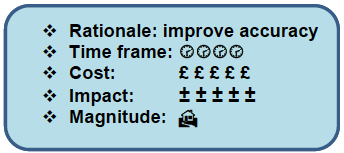
Possible Assessment action:
Require a full SAP assessment when a dwelling is connected to a DH/CHP system.
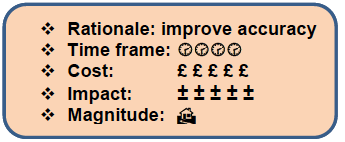
Possible Calculation action:
Consider possible change to convention on definition of a heated corridor in multi-storey blocks connected to DH/CHP systems where the system risers are in the circulation areas.
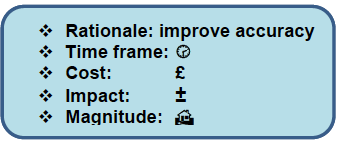
Possible Calculation action:
Consider possible changes to the SAP and RdSAP methodology with regard to ‘penalising’ flat rate charging.
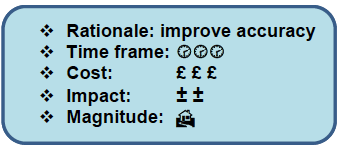
6.7.4 DH/CHP: Appendix T
Issue:
The EPC does not recommend connecting to DH/CHP system as a possible improvement option.
Analysis:
Currently, the EPC does not recommend connection to the local DH/CHP even when this is a local possibility. Connection to a DH/CHP system is not defined in Appendix T. (See Section 6.2 for a fuller discussion on Appendix T issues.) To change this situation would require connecting to a DH/CHP system to be added to Appendix T. Additionally, a convention would need to be defined on when to make this recommendation (to prevent the recommendation being made on properties where no such network was present), for example, when a dwelling was within x meters of a distribution network or the dwelling was located in a block where a DH/CHP system was installed. Two areas where this development would seem particularly appropriate are in Lerwick and in parts of Aberdeen where there are existing DH/CHP distribution networks.
Possible Reporting action:
Include for connecting a dwelling to DH/CHP system within Appendix T.

Possible Assessment action:
Define a convention on when to make the recommendation to connect to a local DH/CHP system.

6.7.5 DH/CHP: PCDB / Real Data
Issue:
Better assessments of DH/CHP systems need operational data rather than defaults built into the PCDB.
Analysis:
Even in a full SAP assessment of dwellings connected to a DH/CHP scheme, the assessor needs operational plant data or design data. Site managers or building owners will hopefully be able to help, but often they may not know the efficiency data of the plant. Without the operation data, the assessor is back to relying on the SAP defaults.
The PCDB is attempting to establish a common resource built into the software of operational data on individual DH/CHP schemes to replace defaults. Currently, this resource includes data on one scheme only (although it is a Scottish scheme, i.e. Lerwick).
If local heat networks are going to be rolled out, then a concomitant requirement from the Scottish Government may be needed to force schemes to either supply the operational data to the PCDB, or establish a system akin to the Display Energy Certificates with the operational parameters and affixed on the boiler house door, so that an assessor could obtain the necessary boiler plant data for the assessment. This would allow the DH/CHP schemes to be modelled more accurately rather than using defaults.
Possible Assessment action:
The Scottish Government could mandate that Display Energy Certificate-type certificates be displayed outside the door on boiler plant setting out the DH/CHP operational efficiencies. This would provide an accessible source of data to the assessor.
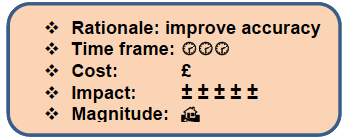
Possible Assessment action:
The Scottish Government should encourage DH/CHP system owners to get the operational parameters of their systems added to the PCDB database.
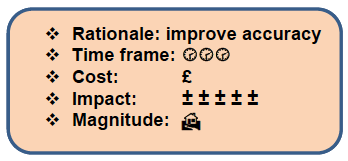
6.7.6 DH/CHP: Metric / Alternative Models / Mapping
The issues raised under these responses (i.e. the impact of DH/CHP on the Building Regulations, the need for alternative models for assessing DH/CHP systems, and mapping heat loads) are outside the scope of this assessment on EPCs.
No further action.
6.8 Technical issue: Ventilation
- Starting Point
- The Metric
- Infiltration Factors
- Air Infiltration Rate Testing
- Improvements
6.8.1 Ventilation: Starting Point
“To limit heat loss, any heated building should be designed to limit air infiltration through the building fabric.”[129] Importantly, this limitation should not compromise ventilation for health considerations, removing moisture, the presence of combustion appliances, and smoke control. BS EN ISO 9972:2015[130] sets out a standard for determining the air permeability of buildings via fan pressurisation testing. The results from a fan pressurisation test can be entered into the full SAP program as part of the process for determining new dwelling compliance with the Scottish Building Regulations. If the results of an air pressurisation test are not available, then SAP will estimate the infiltration rate from a number of variables (see Supplementary Topic Note 5 on Ventilation for a more detailed discussion).
Table S5 of SAP 2012 Appendix S describes the factors which will impact on an estimation of the air infiltration rate of a property through RdSAP. However, many of these factors are not data items that the assessor can inform through the survey of a property as they are assumed by the program. An existing dwelling receives no credit in RdSAP for a draught lobby, and adding a draught lobby would never appear as a recommendation. An RdSAP assessor only collects data specifically on three ventilation parameters. The rest are determined from other data by the program, e.g. age of construction determines the number of extract fans.[131]
As part of this project, a comparative exercise was carried out on 183 properties on the impact of replacing known ventilation variables with the RdSAP defaults[132]. Within this sample of dwellings, RdSAP was found to underestimate the ventilation losses overall because it defaults on the presence of a draught lobby, the number of flues and the number of extract fans within a dwelling, and as a result overestimated the SAP and Environmental Impact scores, and underestimated the SAP calculated fuel bill, CO2 emissions and energy consumption.
6.8.2 Ventilation: The Metric
Issue:
SAP / RdSAP need to take account of local wind speed.
Analysis:
In areas of the country with high average wind speeds, (e.g. the Hebrides, Orkney, Shetlands, and the Highlands) unwanted ventilation may be a significant factor in a dwelling’s heat loss. Interestingly, RdSAP in part accounts for this when it estimates the dwelling’s space heating fuel bill, because the program accesses the postcode sector of the PCDB to complete this calculation: each post code sector has its own set of monthly wind speed factors. However, for the SAP assessment, and any associated recommendations, the program ignores local climatic data, and only uses the default UK climatic data. Without changing the underlying basis of the SAP metric, this dichotomy is not going to change.
No further action
6.8.3 Ventilation: Infiltration Factors
Issue:
There are too many assumptions about ventilation within RdSAP. More options are required in the ventilation calculation to take account of poorly fitting windows and doors, retrofitted mechanical ventilation, and extract fans.
Analysis:
In RdSAP, only three ventilation variables are informed by the dwelling assessment and entered directly into the program:
- the percentage of draughtproofed doors and windows;
- the number of open fireplaces; and,
- the presence and type of a mechanical ventilation system[133].
The SAP-RdSAP comparative exercise on ventilation inputs found that switching from the actual ventilation variables in full SAP to the RdSAP defaults resulted in a reduction of the air infiltration rate of 0.08 air changes per hour (that is, a lower ventilation loss) with a consequential 0.62 point increase in the SAP score and 0.55 point increase in the Environmental Impact score. Fuel costs, CO2 emissions and energy consumption all decreased: an annual saving of £17.81 on the SAP fuel bill; a 107 kg decline in the yearly CO2 emissions; and an energy consumption of reduction of 535 kWh across the year.
Replacing defaulted ventilation data within RdSAP with actual dwelling data would not add significantly to the time to complete a survey: all rooms are already visited and details noted. Including a count of the number of extract fans, air bricks, and flues, and noting the presence of a draught lobby would be part of this assessment. Allowing this data to replace the RdSAP defaults currently used would not require new ventilation algorithms as they are defined in full SAP already.
A convention in SAP and RdSAP already exists for distinguishing between chimneys and flues; however, there is no convention on scoring air bricks.
Possible Calculation action:
Allow the actual number of extract fans, air bricks, and flues, and the presence of a draught lobby to be entered within RdSAP programs.
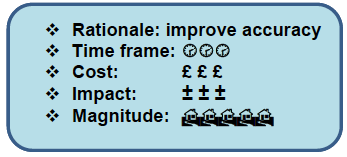
Possible Assessment action:
Define a convention in RdSAP for assessing air bricks.
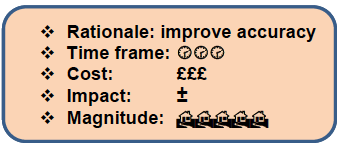
No further action:
The condition of window frames or the fitting within the building fabric is not part of the EPC assessment. Air infiltration because of badly fitting windows, or any other breaches of the building envelope, would be better assessed using Air Infiltration testing (see next section).
6.8.4 Ventilation: Infiltration: Air Infiltration Rate Testing
Issue:
RdSAP does not allow for Air Infiltration Test results to be included.
Analysis:
Air Infiltration Rate testing is included within the Scottish Building Regulations under Section 6[134], as part of determining compliance with the regulations. Importantly, the results can be entered into the full SAP program so, rather than estimating ventilation rates, actual measured data is used in the SAP calculation. At least one HEEPS ABS monitoring project is proposing that air infiltration rates are measured as part of the data collection as part of the assessment of the impact of improvement works on existing dwellings[135]. While there should be no requirement that air infiltration rate testing is carried out as part of an RdSAP assessment, given its cost, where the data is available it should be allowed to be used in the RdSAP program, subject to the testing meeting the BS EN ISO 9972: 2015 standard. This would require modifications to the RdSAP software, but the necessary algorithms are already present in the full SAP program.
The requirements for air infiltration rate testing of some new dwellings are nurturing a nascent industry. Allowing the results to be used in the assessment of existing dwellings, through incorporating it into RdSAP, would be additional boon.
Further, for existing dwellings, it would move the consideration of reducing unnecessary air infiltration away from just focussing on the draughtproofing of doors and windows, onto a more holistic and robust assessment of a dwelling’s ventilation needs and infiltration rates (see section 5.7.6 below). Testing could also highlight potential problems of existing buildings being made too air tight through fabric improvement measures, and ensure that sufficient ventilation was included within improvement specifications.
Possible Calculation action:
Allow for air infiltration rate test results to be entered into RdSAP.
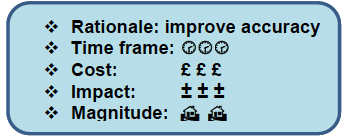
Possible Assessment action:
To support the inclusion of air infiltration rate test results within RdSAP, define a convention governing the necessary standards to be met by the tests, the qualifications of those carrying out the tests, and the requisite documentation to support this development. Existing industry standards already exist, and are accepted by the Scottish Government, with regard to testing new dwellings and Building Regulations compliance so could be readily incorporated into RdSAP conventions.

6.8.5 Ventilation: Improvements
Issue:
The impact of reducing air infiltration and draughtproofing is not adequately accounted for in RdSAP
Analysis:
Much of this concern appears to revolve around draughtproofing improvements not seeming to appear as recommendations on the EPC.
Both SAP and RdSAP include a wide range of variables within the assessment of a dwelling’s ventilation rate. No single ventilation factor on its own is going to make a significant impact on the ventilation rate because of the many variables that contribute to the derivation on the air infiltration rate. Whereas in a full SAP assessment these are all detailed, in RdSAP most are default values.
Draughtproofing is assessed as part of an RdSAP dwelling survey, and is included within Appendix T as a possible improvement recommendation when the level of draughtproofing is less than 100%. Unfortunately, its impact on the SAP score is often going to be less than +0.95 SAP points so it will not appear on the EPC as a recommendation because of the Appendix T rules (see Section 5.3).
Possible Reporting action:
Amend the Appendix T rules so that draughtproofing is included as an improvement recommendation when the level of draughtproofing of the windows and doors is less than 100%.

6.9 Technical Issue: Measuring Windows
- Starting Point
- Measuring Windows
- Window U-values
- Recommendations: Secondary Glazing
- Recommendations: Shutters
6.9.1 Measuring Windows: Starting Point
Glazing-related issues were not identified specifically by many respondents to the public consultations. However, the expressed concerns about inconsistencies between surveyors and the gap between actual energy performance and the modelled performance of a dwelling (discussed in other topic notes) are evident in the discussion on whether EPC assessors should measure windows or not, and inconsistencies between SAP and RdSAP.
Within RdSAP, the measurement of individual windows is not required if the overall window area of the dwelling is assessed as ‘typical’, ‘more than typical’ or ‘less than typical’ (see Supplementary Topic Note 6 on Measuring Windows in RdSAP). Yet, RdSAP Appendix S does not define anywhere what is ‘typical’ other than provide the algorithms the programs use to calculate ‘typical’ window area for a given dwelling type, age, and floor area. The assessor is not helped in this process as none of the currently available approved RdSAP software programs[136] assists the assessor by displaying what the typical window area would be for a given dwelling type, age and total floor area. Effectively, the only way for an assessor to confirm whether a dwelling’s window area is ‘typical’, ‘more than typical’ or ‘less than typical’, or not, is to actually measure all the window areas, aggregate the areas, calculate the typical window area from the appropriate Table S4 algorithm, and then compare the two areas manually. In other words, the assessor needs to measure the windows to confirm that the assessor does not need to measure them – Catch 22. The result is that some assessors never seem to measure windows, always classifying them as typical; others always measure windows regardless of whether they believe the glazing area is ‘typical’ or not.[137] This assessor discretion on whether to measure windows or not will give rise to some inconsistencies between assessors.
RdSAP 2012 introduced a divergence between SAP and RdSAP with regard to the default U-values associated with wood and uPVC-framed double glazing. In Table 6e of the SAP 2012 manual[138], wood and uPVC-framed double glazing have identical U-values as long as the glazing gap and other factors for the two types of double glazing are the same. RdSAP 2012 introduced variable U-values for pre-2003 uPVC-framed double glazing based on the thickness of the glazing gap[139] while pre-2003 wood-framed double glazing only has one default regardless of the thickness of the glazing gap. Overwriting the wood framed double glazing U-value in RdSAP with a SAP Table 6e value is not allowed under RdSAP convention 3.10[140].
6.9.2 Measuring Windows
Issue:
To reduce inconsistencies between assessors, and between building assessments and actual energy performance, individual windows should be measured.
Analysis:
In RdSAP, the conventions require assessors to measure individual windows when there is more than 30% more than typical window area, or more than 30% less than typical window area. A study comparing the actual window measurements of 1398 Scottish dwellings with the areas predicted by the RdSAP algorithms found that these algorithms over-estimated the window area across most Scottish dwelling types when broken down by dwelling type and age band by more than 30%. In only three age band by house type groupings (1930-49 flats and maisonettes, 1950-64 flats and maisonettes, and 1984-91 flats and maisonettes) did RdSAP over-estimate the window area by less than 30%, and in two of these it was still more than 25% out (see Supplementary Topic Note 6 on Measuring Windows in RdSAP for the full results).
These results indicate that the default position for RdSAP assessors in Scotland should not be to assume that the window areas are typical and not measure; rather, they should assume that window areas are much less than typical compared to what the RdSAP window algorithms would predict, and measure the individual windows. Over-estimating window area has a direct consequence when it comes to assessing the benefits of wall insulation in RdSAP: the more window area subtracted from the total wall area, the less residual wall area to benefit from wall insulation. The impact of using actual window measurements, compared to the RdSAP defaults, is examined through a case study of 28 tenemental flats that received internal wall insulation in 2015/6 in Supplementary Topic Note 6 on Measuring Windows in RdSAP.
Requiring assessors to measure windows would increase the time in the dwelling, and increase the time entering the data into the software, and likely increase the cost of RdSAP assessments to householders (because an assessor would not be able to do as many per day). The results from doing so however would be in keeping with the actual dwelling, and would ensure greater consistency between assessors by removing any discretion in deciding when to measure windows. As measuring individual windows would require data to be collected on the orientation and draughtiness of the individual windows this would allow the benefits of passive solar gains to be better modelled and air infiltration rates to be better assessed (see Section 6.7).
The alternative in Scotland to requiring assessors to measure individual windows would be to adjust the window algorithms to be more appropriate. This exercise would involve data collection and modelling work, and the subsequent re-writing of the algorithms within RdSAP. Requiring assessors to measure windows and enter the data into the program would require only a change in the convention. All the RdSAP software programs already have the function to input individual detailed window data, and would require no amendment to the software.
Possible Assessment action:
Change the convention to require RdSAP assessors to measure individual windows in all RdSAP assessments in Scotland.

6.9.3 Window U-values
Issue: Inconsistencies between SAP and RdSAP on uPVC and wood double glazed U-values.
Analysis: As already noted above in Section 5.8.4, RdSAP 2012 introduced a divergence between SAP and RdSAP with regard to the default U-values associated with wood and uPVC-framed double glazing, based on the thickness of the glazing gap. There does not appear to be an explanation why this variation was not also applied to similar glazing gaps with wood double glazing.
Possible Calculation action:
Include variations in pre-2003 wood double glazing default U-values to take account of different thicknesses in the glazing gap.
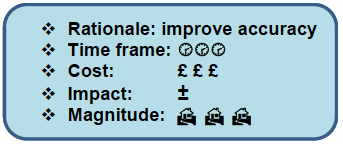
6.9.4 Secondary Glazing
Issue:
Secondary glazing is not included within the EPC recommendations.
Analysis:
The issue here is not that RdSAP does not recommend secondary glazing, but that such a recommendation is trumped within RdSAP by the recommendation to install replacement double glazing. Appendix T includes secondary glazing amongst the options to be assessed by RdSAP programs when assessing the improvement options for a dwelling. However, within the Appendix T hierarchy, replacement double glazing is also assessed and, as only one recommendation per building component replacement is made on the EPC; double glazing takes precedence over secondary glazing.
Within RdSAP, an assessor could remove replacement double glazing from the recommendations for a dwelling, with secondary double glazing then likely to be recommended in its place. The RdSAP conventions require an assessor to have documented reasons for removing a recommendation, and that being “a listed building or a property in a conservation area is not sufficient grounds in its own right to suppress a recommendation.”[141]
Possible Calculation action:
Amend Appendix T so that both a recommendation for secondary glazing and replacement double glazing can appear on the EPC.

6.9.5 Shutters
Issue:
Shutters are not recommended in RdSAP.
Analysis:
In Section 6.2.11, assessing the impact of existing shutters was looked at in the context of traditional buildings. Currently, shutters are not included within an RdSAP assessment, and therefore are not part of the recommendations included in Appendix T. To get shutters included in the recommendations, shutters would need to be incorporated into the RdSAP methodology and software, and into Appendix T.
Possible Calculation action:
Incorporate shutters into the RdSAP methodology and into Appendix T.

Contact
Email: Steven.Scott@gov.scot
There is a problem
Thanks for your feedback